Rachael Dickzen's Blog, page 14
November 10, 2019
My Obsessive Shakespeare English History Play Family Tree (from Richard II, Henry IVs, Henry V, Henry VIs, Richard III, AND NOW HENRY VIII))
Originally published October 21, 2019
Things I should have blogged about today: Six the Musical costumes (still working on it!), things I learned at the Emerging Writers Festival, the authors I met at the National Book Festival, TudorCon (just got back!), More #ShakespearesPlaylist
Things I actually worked on today: An overly detailed family tree of English monarchs involved in the Hundred Years’ War and the Cousins’ War (also known as the War of the Roses), as portrayed in various Shakespeare plays, including Richard II, Henry IV Part 1 and 2, Henry V, Henry VI Part 1, 2, and 3, and Richard III. This started as a way for me to sort out my own thoughts and for eventual distribution to the cast members of the Richard III production for which I’m stage managing, but it may have gotten a little too obsessive to be helpful at this point, lol.
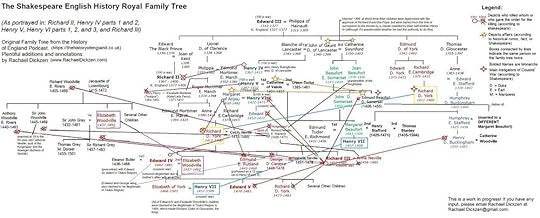
Updated on 10/22 to add in the Woodvilles- while not royal, they are very important! I’m going to keep editing and working on this to make it more comprehensive and also to clear up some of the more obscured names on here.
I started with the wonderful family tree over at The History of England Podcast website (Thank you very much!) and modified it in a lot of ways, erasing some descendants that aren’t mentioned in the plays or super relevant, adding in others that are, etc. I also added in various notes to indicate “who killed whom” (or was ultimately responsible for the death) according to Shakespeare and “who had an affair with whom” (according to Shakespeare or historical fact or rumor). [NOTE: a lot of these deaths and affairs are not at all confirmed in history and I am in no way saying it actually happened that way, don’t at me.]
My conclusion is that everyone’s related (thus, the cousins’ war!), no one has ANY IMAGINATION WHATSOEVER when it comes to naming, and everyone killed everyone else’s relatives in some way.
Did I miss someone important? It’s totally possible! Half of these people have the same damn names!
Shakespeare has a whole bit in Richard III Act IV Scene 4 poking a little fun at that. I’ve put in notations to indicate which one is being talked about at which point because it is DAMN CONFUSING.
Queen Margaret. (speaking to Elizabeth Woodville)
Tell o'er your woes again by viewing mine:
I had an Edward (Edward, Prince of Wales [son of Henry VI and Margaret of Anjou]), till a Richard kill'd him; (Richard, Duke of Gloucester/Richard III)
I had a Harry (Henry VI), till a Richard kill'd him: (Gloucester/R 3)
Thou hadst an Edward (Edward V [son of Edward IV and Elizabeth Woodville]), till a Richard kill'd him; (Gloucester/R 3)
Thou hadst a Richard (Richard, Duke of York [son of Edward IV’s and Elizabeth Woodville), till a Richard killed him; (Gloucester/R 3)
Duchess of York. I had a Richard too, and thou didst kill him; (Richard, Duke of York [father of Edward IV, Clarence, and Gloucester/R 3; also Duchess of York’s late husband])
I had a Rutland too, thou holp'st to kill him.
Anyway, If I DID miss someone or got something wrong in this family tree, please let me know; it would be most appreciated!
UPDATE NOVEMBER 10, 2019
I added a few more generations and cleaned up a lot of the more illegible names. : ) This goes far beyond anything mentioned in Shakespeare’s history plays, but I wanted to add in all the relevant potential heirs under Elizabeth I.
I also reformatted and cleaned it up a lot. I printed out a big copy of this and mounted it on foam-board for demonstration purposes at Richard III rehearsal. I got to teach all about the wars of the roses and history and it was so much fun. :D Please feel free to download it and use it for your own purposes! But if you do so, please comment and let me know what you’re doing with it, I’d love to know!
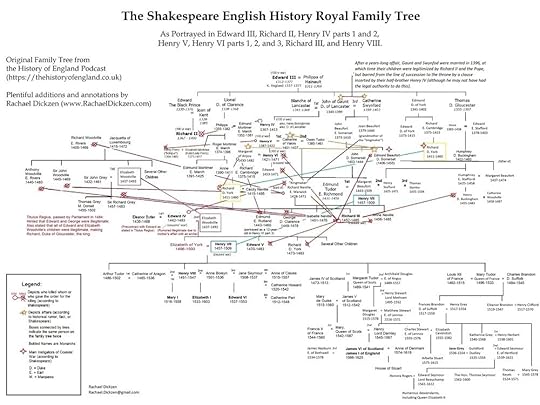
November 3, 2019
The Alternate Costumes of Six the Musical, Compared to the Main Queens' Costumes
This is the third post in a series on Six the Musical Costumes: I’ve analyzed the historical and modern inspirations in the main queen costumes previously, for Wives 1-3 and Wives 4-6 .
Because of its small cast and rabid fanbase, Six has the ability to get away with things that I’m not sure would fly in any other musical. Specifically, each alternate has their own costumes that are separate from the main Queen costumes. In other musicals and plays, it’s standard practice for alternates and understudies to wear the same costume/style of costume as the main actors, with the idea that they should blend in as much as possible. But Six encourages their alternates to stand out and online, the alternates have almost as much of a rabid fanbase as the main actresses!
An Alternate is a performer who occasionally goes on in a role to give the main performer a break. Their performances are usually scheduled. From what I can see online, it seems like each production of Six generally has 2-3 alternates that sub in regularly, primarily for two specific queens. London also has an understudy, who will only go on stage if someone is unexpectedly out, like if an actress is ill. Seems like the formal alternates also jump in as understudies if need be.
It seems like the costume designer and creators have a lot of fun with the alternate costumes, using colors and styles that don’t show up in the main queens’ outfits. None of the costumes are exact copies of any of the queens’ outfits, but they do take a lot of inspiration from them.
I’ll point out a few of the different hairstyles here, but for the most part, I plan to just talk about the different elements of the alternate costumes - which queens they came from, etc.
A TON of people on Tumblr have done more in-depth coverage and include more pictures:
Grace Mouat’s Costume- https://divorcedbeheaded.tumblr.com/post/184743930784/so-as-you-know-the-understudies-cover-all-six
A review of the black and blue alternate costumes: https://lightleckrereins.tumblr.com/tagged/six-alternates
A great overview of all the costumes: https://six-costume-refs.tumblr.com/
Various Instagram Sources: sladegabriella, camden costumes, dxntloseurhead
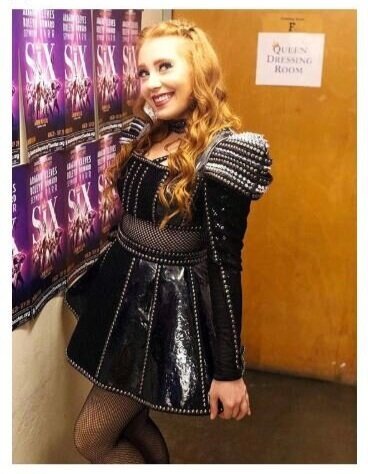

Let’s start with a look at the black alternate costumes. The alternates change up their hair and makeup to match each queen’s style, and it does seem that certain styles of alternate costumes are worn only with certain queens.
Mallory Maedke is currently the alternate for Boleyn, Seymour, and Howard for Six the Musical: US. As you can see in the left and middle photos, she’s clearly wearing the same or very similar costumes, but her hair is done differently. On the left, she’s going on as Jane Seymour, with the long flowing hair pulled back away from the face, without any studded accessories. I don’t know for certain who she’s playing in the picture on the right, but based on the hair and the wristbands, I’m guessing Anne Boleyn.
These alternate costumes are so interesting, because they have enough elements in common with the usual queen costumes to blend in with the style of the show, but they tend to have a few unusual touches all their own. The grommets and stripes are the most obvious common elements with the other costumes. This dress also has a skirt similar to that seen on Aragon’s, but with more panels, and it goes all the way around. The mesh is similar to that in Boleyn’s outfit and the long sleeves are similar to Seymour’s. The top of the sleeves however is a totally unique feature you don’t see in any of the main queens’ looks. They have a very strong profile and almost look like ribbon on a Christmas present.
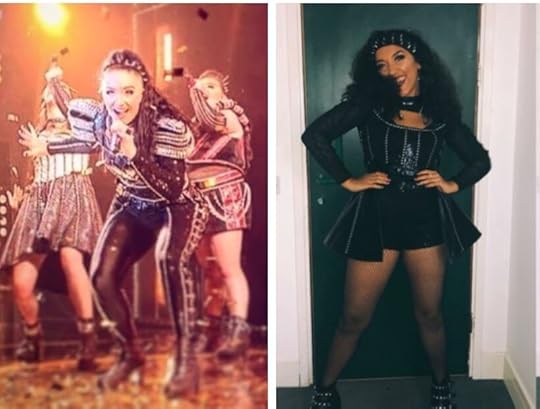
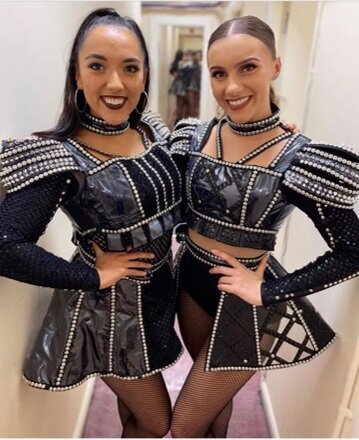
Left: Natalie Pilkington-Bliss costume (cruise alternate) as Catherine Parr. I’m guessing she’s in character as Catherine Parr in this picture, as she’s got on those distinctive pants. She also has similar sleeves as can be seen in the previous black dress. I wish I could get a better look at the rest of the costume - I struggled to find pictures of this one, but I really enjoyed her pose in it, so I wanted to include it.
Middle: Grace Mouat (West End, London), probably going on as Catherine of Aragon, based on the hair. Mouat HAS understudied for all the queens before but her primary roles were as Aragon and Howard. This costume basically has Aragon’s skirt and Seymour’s neckline and sleeves. I believe this is one of the earlier alternate costumes, intended to be used for all the queens, before they started making variations specific to certain characters.
Right: Mouat and Colette Guitart (understudy, West End) - You can see the details of Mouat’s costume a lot better here - it’s very similar to Maedke’s dress, but appears to have little epaulettes, which seems evocative of castle crenelations or modern military dress. Guitart’s dress has a similar neckline and sleeves, but the top has fewer vertical stripes and more criss-crossing straps. The see through panels in the skirt are very similar to Howard’s skirt.

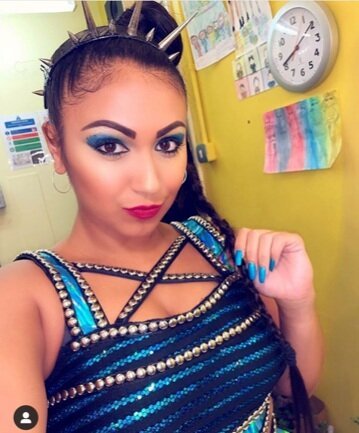
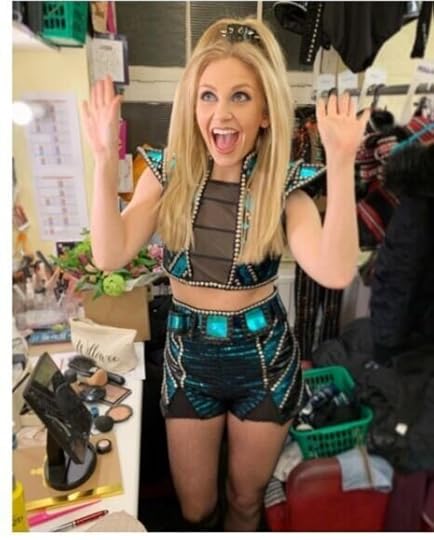
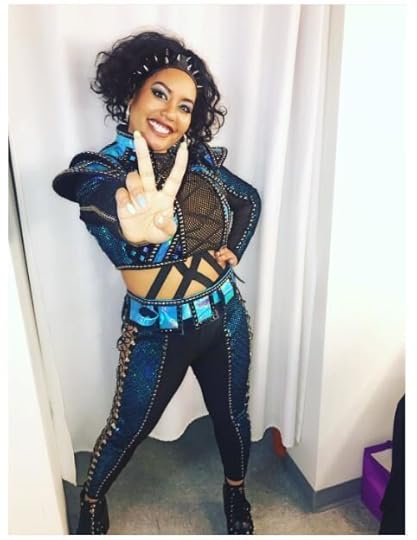
Next - the teal/blue costumes!
Left - Vicki Manser (West End) - Anne of Cleves variation - Here’s where you can see they really started having fun with the costumes. Vicki’s shorts are kind of similar to Cleves, but higher waisted and cut differently - they’re much more classically sci-fi in their looks, particularly with that color! The jacket and top underneath are pretty much straight Cleves, complete with the fur, although the arm warmers are different than Cleves’. The criss cross straps at the type emulate those seen on Cleves and Howard.
Second to Left: Cherelle Jay (West End) - This looks to be a similar top as Manser is wearing on the left, only without the jacket. However, the bottom horizontal strip appears to be a lighter blue.
Second to Right: Vicki Manser - All queens except Cleves - The shorts seem identical to the left outfit, although I can’t quite tell if the belt detail is the same; there may be epaulettes at the top? It’s hard to tell. That top though is just delightfully bizarre and totally unlike anything else. It has the shape of Boleyn’s top, with the see-through cut out of Catherine Parr’s top. The horizontal stripes aren’t visible in any of the main queen’s costumes, which all use either diagonal or vertical (or checked in Boleyn’s case).
Right: Nicole Kyoung-Mi Lambert (US) - Aragon/Parr variation – The pants are pure Parr, although the fabric strips connecting the top and the pants are very different and seem to emulate Cleves’ or Howards’ criss-cross straps on their neckline. The top is very similar to the middle Manser look (with the Boleyn style cut and sleeve tops and the Parr style see through cut out), only with the long sleeves of Seymour. It seems to have similar possible epaulettes/belt thing as the Manser look, but with more of them.
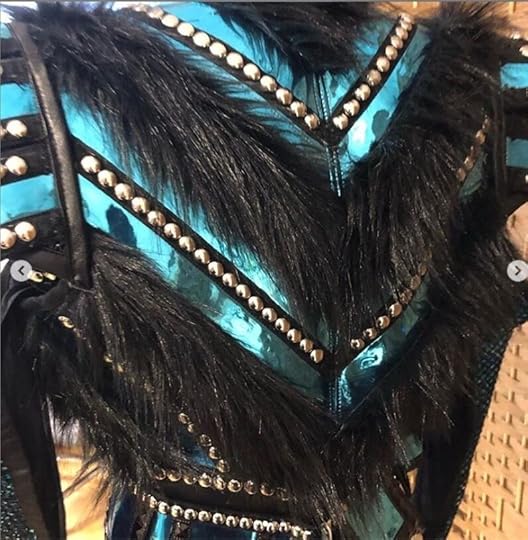

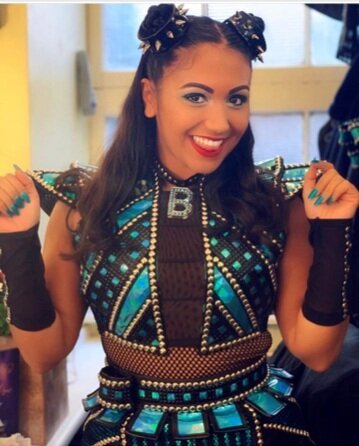
Left: Pretty sure this is just a close up of the back of the jacket in the left Manser picture above, I’m pretty sure. It’s just so pretty that I had to share it again. I think the fur is so lovely and striking.
Middle: Bryony Duncan - Boleyn/Seymour/Howard - This looks almost exactly like Boleyn’s dress in silhouette, sleeves, wristbands, mesh, and skirt fullness, only the checks are diagonal instead of straight up and sideways. In addition, she has the cut out in the middle like Parr.
Right: Cherelle Jay (West End) - Dressed as Boleyn. The top seems very similar to the Duncan outfit in the middle, with all its similarities to Boleyn’s dress but the bottom has the Cleves belt and the epaulettes seen in the Manser outfit.
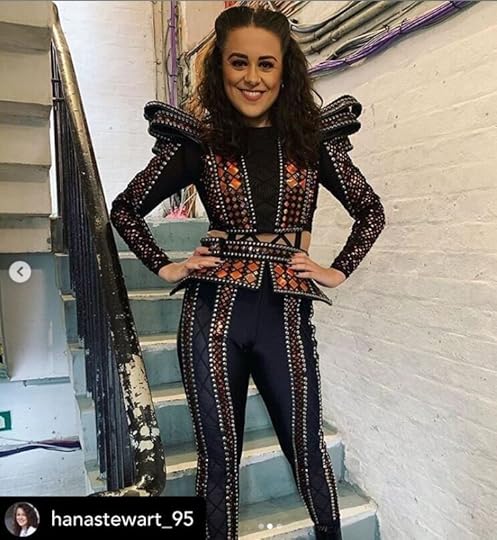
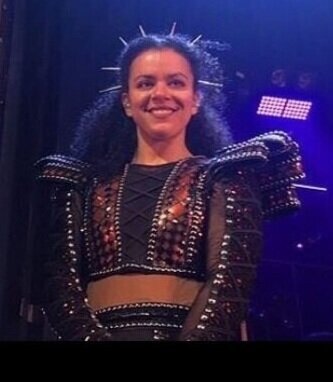
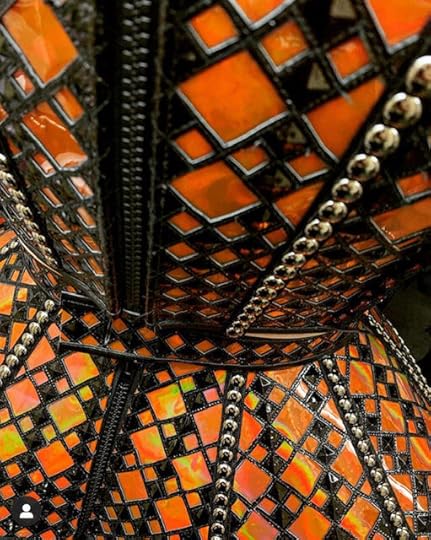
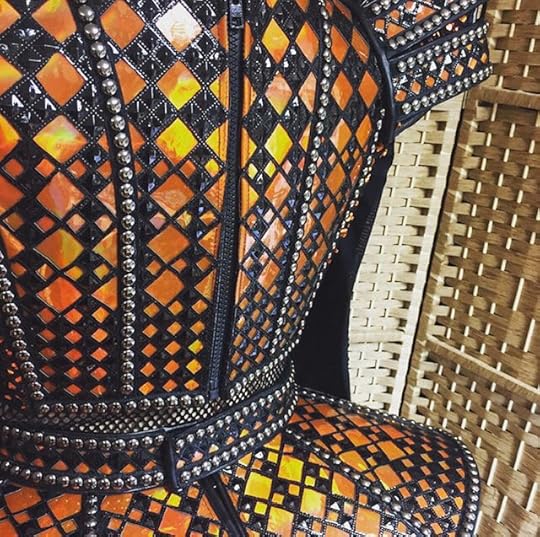
On to the Orange costumes!
Left: Hana Stewart (West End), who alternated primarily as Jane Seymour and Catherine of Aragon. This top seems to be very similar to the Maedke costume at the very top of the page, only with more busy ribbons on the sleeves - the tops of these sleeves appear to have four individual sections, while the Maedke sleeve tops appear to be one accentuated cap sleeve. The middle black stripe is similar to Catherine Parr’s, but without the sheer fabric. The criss cross laces on the top and the pants appear to be reminiscent of corset laces historically.
Second to Left: Courtney Stapleton (West End), who alternated primarily as Jane Seymour and Catherine Parr, but also understudied all the other roles. From the hair accessories, it looks like she’s probably going on as Catherine of Aragon or Cleves. This costume looks the same as Stewart’s, except it’s missing the straps in between the top and pants.
The two photos on the right are from the instagram accounts of costume designer Gabriella Slade and Camden Costumes, one of the people who sew and assemble the costumes. I don’t think these costumes have been used in the show yet, as I can’t find any photos of them anywhere, but they do look really interesting and exciting for the future! The costume in the second from the right looks very similar to the shape of Catherine of Aragon’s dress, but has the checks of Boleyn. The one on the far right reminds me most of the current orange costume, with its peplum, but it has the mesh of boleyn’s costume. The belt detail seems borrowed from Cleves’ shorts.
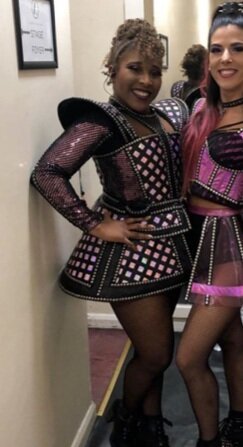
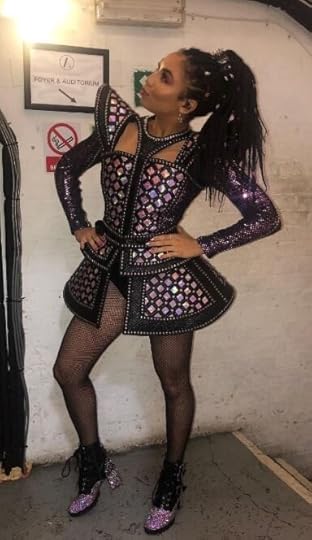
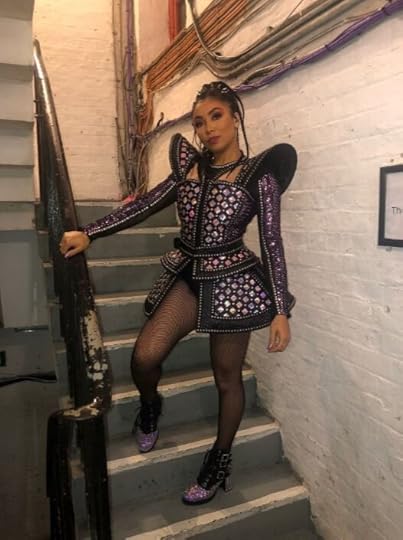
Finally, the pink costumes!
Shekinah McFarlane (West End), who alternated primarily for Aragon and Cleves. It appears that when she stood in for Cleves though, she wore the regular costume instead of a special alternate costume. She now is Cleves on the UK Tour. This lovely opalescent pink dress has the general shape of Aragon’s dress, with the split skirt and long sleeves. The sleeve top is similar to the blue Duncan costume above, with a Jetsons sort of feel to it. The neck decoration is really interesting - I love how it continues the vertical stripe in the bodice up around the neck. Haven’t seen anything like that in the other costumes. This outfit also has a split peplum on the skirt, which feel similar to the epaulettes seen in other alternate outfits, but is different enough that it stands apart.
Zara McIntosh (West End), who alternates for Howard and Aragon. In these photos, she’s made up for Howard. It’s clearly the same or similar style dress as the one McFarlane is wearing.
I haven’t seen any other opal pink costumes but the fabric is absolutely gorgeous, so I certainly hope that changes soon!
Thanks everyone! Next week, I hope to get a post up about the evolution of the costumes from the early days of the musical to what they’re like now. It is National Novel Writing Month though, so I may be short on time this month.
October 27, 2019
The Historical and Modern Inspirations in the Costumes of Six the Musical: Wives 4-6
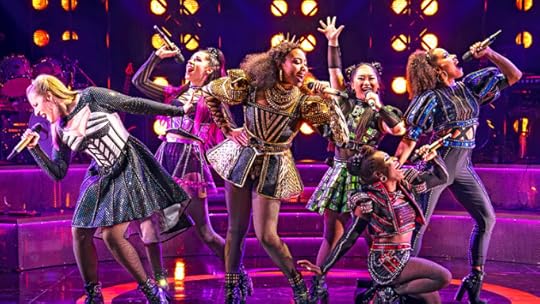
The cast of Six at the Chicago Shakespeare Theater. From left, Jane Seymour (Abby Mueller), Katherine Howard (Samantha Pauly), Catherine of Aragon (Adrianna Hicks), Anne Boleyn (Andrea Macasaet), Anne of Cleves (Brittney Mack), and Catherine Parr (Anna Uzele).
The first post on the costumes of Wives 1-3 can be found here .
So I’ve gotten pretty obsessed with the musical Six lately, which is based on the lives of the six wives of Henry VIII. It’s set up as a girl group pop concert, in which the six women each sing the stories of their lives.
I’ve been dying for more information about the costumes in the show and haven’t been able to find a ton of information. The costume designer, Gabriella Slade, was nominated for an Olivier award for her work. In one article, she said:
“It was an amazing brief. There needed to be an echo of Tudor fashion, but obviously the contemporary influence of the pop industry. It’s an amazing thing to be able to infuse period costume with contemporary style. Lucy [Moss, writer] had ideas about which pop stars related to which queens. Catherine of Aragon is Beyoncé, Jane Seymour is Adele, Catherine Parr is Alicia Keys, Catherine Howard is Ariana Grande, Anne Boleyn is Lily Allen and Anne of Cleves is Nicki Minaj meets Rihanna.”
Other than that though, I haven’t been able to find a lot about her process or inspiration in designing these costumes. So I decided to look into the costumes myself. I’ll be directly comparing them to their historical counterparts and their modern pop artist inspirations.
These are all just educated guesses (based on lots and lots of reading and photo/portrait examining), but I am by no means a fashion or a pop music expert! If you have any contributions or comments, please send them my way - via the comments here, Twitter (@RachaelDickzen), Facebook (@RachaelDickzenAuthor), or email at Rachael.Dickzen@gmail.com. I’d love to hear what you have to say!
This is the second of several posts on the costumes in Six. The first post on the costumes of Wives 1-3 can be found here. The third will take a look at the alternates’ costumes! I also want to do a post looking at how the costumes evolved over time.
Historical Note: Spelling wasn’t standardized in Tudor times, so you’ll see these Queens’ names spelled a number of different ways.
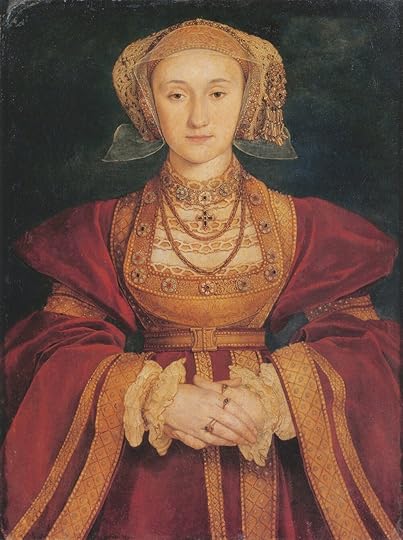
Anne of Cleves, by Hans Holbein the Yougner, c. 1539. Oil and tempera on parchment mounted on canvas.
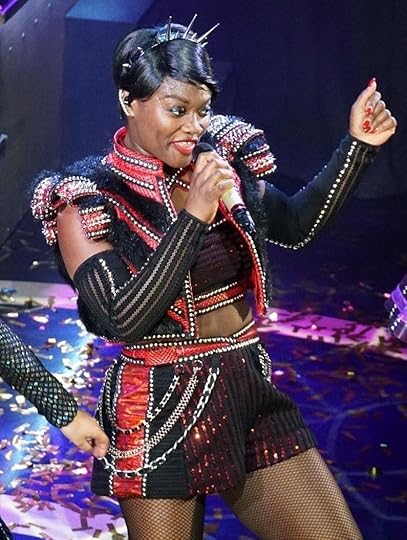
Anne of Cleves (Alexia McIntosh) in the West End production of Six, Unknown Photographer
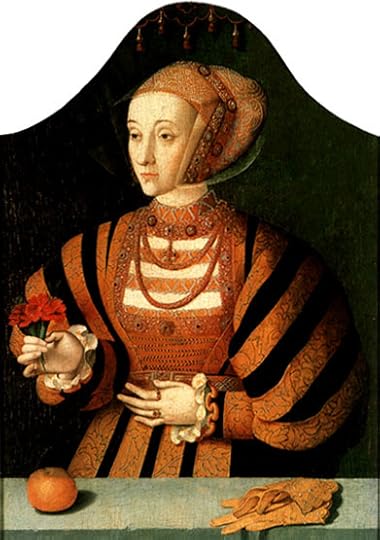
Anne of Cleeves, ~1540s by Barthel Bruyn the Elder
Ich bin Anne of Cleves (Ja)
When he saw my portrait he was like- (Jaa)
But I didn’t look as good as I did in my pic
Funny how we all discuss that
But never Henry’s little-
Anne of Cleves (Queen from January -July 1540) has been one of the queens most maligned by Tudor Propaganda. Even today, if I refer to her, my husband asks “the one who looked like a horse” (he knows better, he just says it to mess with me because it’s such a common misconception). Here’s the thing: Henry saw a painting of Anne by Hans Holbein beforehand and liked what he saw. Holbein had been specifically instructed NOT to flatter the women in the portraits. If the portrait of Anne was indeed so inaccurate, would Henry VIII have then kept Holbein in his employment afterward? No. Thomas Cromwell lost his head over the whole Anne of Cleves incident; Henry certainly wouldn’t have kept around a junior-level painter (yes, he was junior, Holbein was never the highest paid painter in Henry’s employ. But he’s the one we all know several centuries later, so /shrug/) if he actually believed Holbein messed up so badly. In addition, everyone at the time said it was a good likeness of her.
So who was Anne? Anna von Kleve, as she was known in German, was the second daughter of a Duke in Cleves. Her father was heavily influenced by humanism and wanted to follow a moderate path toward reformation, but the family itself was unaligned religiously; her brother was a Lutheran and her mother was described as a strict Catholic. Anne was betrothed to the Duke of Lorraine at the age of 11. Though this betrothal was never fulfilled, it was later used as an excuse to annul her marriage with Henry. Henry’s chief minister Thomas Cromwell pushed Anne forward as a candidate because of her connections to Protestantism (her brother-in-law John Frederick, Elector of Saxony, was called “The Champion of the Reformation”).
Though Henry VIII later stated that Jane Seymour was his favorite wife and claimed to have mourned her fiercely, in reality, he started looking for a new wife pretty soon after her death. He sent Hans Holbein the Younger around Europe to paint pictures of numerous eligible women, including Anna and her younger sister Amalia. Holbein also painted Christina of Denmark, who famously said “If I had two heads, I would happily put one at the disposal of the King of England.”
There likely was one specific incident at the heart of Henry’s dislike of Anne. Henry was actually quite a romantic and fancied himself a chivalric knight, so in the tradition of courtly love games, he disguised himself, rode out to meet Anne early without any warning, and surprised Anne with a kiss and a gift. She had no idea who he was, didn’t know anything about this courtly love tradition, and was rather shocked and freaked out by the unknown man who tried to embrace her. She was polite, but didn’t pay much attention to him until he took off his disguise and came back in all his kingly splendor. The situation likely wounded Henry’s pride, and immediately after he tried to get the wedding called off, stating that he “liked not her looks.” It couldn’t be done without endangering their vital alliance with Anne’s family, so the wedding went forward, but the marriage only lasted about half a year (the “Flanders Mare” phrase used to describe Anne, by the way, didn’t show up in any contemporary evidence and wasn’t used in any descriptions of her until 1679).
Henry claimed the marriage was never consummated and Anne never said anything to the contrary. Henry asked for an annulment, Anne (who probably was thinking of what happened to Catherine of Aragon) consented, and in return, was given a generous settlement of numerous estates. She also was referred to as “the King’s Beloved Sister,” and was given precedence over all women in England save his own wife and daughters. Anne stayed in England for the rest of her life, outliving both Henry and his son Edward IV and living well into the reign of Mary I.
Historical inspiration: The portrait’s influence can be seen in the red color scheme and stripes present in Anne’s costume. The shape of the costume seems to pay homage to the Holbein painting as well; the crop top mirrors the belt at Anne’s waist and the puffed sleeves, gloves, and the arms peeking through emulate the length and volume of the dress’s sleeves. Even the high collar on the jacket and the criss-crossing straps on the chest seem to refer to Anne’s necklaces.
If you look carefully, this costume also features black fur, which may be a reference to Anne’s German background. Alternatively, it may just symbolize how cold it really was at the time; the English renaissance took place during a “little ice age,” after all. It was not uncommon for dresses to be lined with fur for warmth then. We know that canals and rivers (including the great Thames in London) froze frequently enough that “frost fairs” would be held on the solid ice.
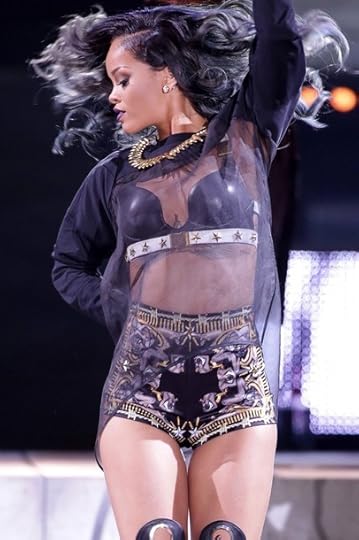
Rihanna on the Diamonds World Tour
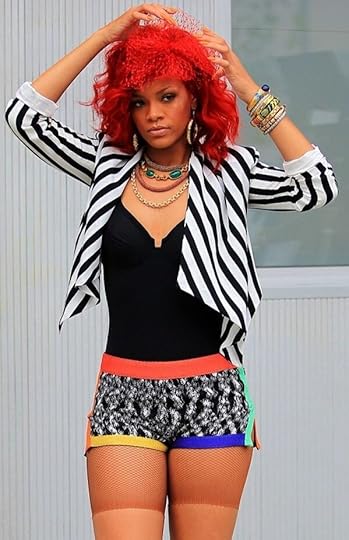
Rihanna in the What’s My Name music video

Rihanna
Modern Inspiration: The Rihanna influence is pretty apparent. Rihanna has often worn crop top and short sets, stripes, and spikes. The West End actress’s pixie cut is similar to Rihanna’s ever-changing hair, which has been cut very short several times; you can see in the photo at the top of this post that the actress in the Chicago production has her hair done in a bun which keeps it similarly close to the head.
I’ve also read interviews that say Cleves is also loosely inspired by Nicki Minaj; I’ve included some Nicki pictures that show her in shorts and spikes, just like Cleves.
The song itself actually reminds me much more of Fancy by Iggy Azalea than any of Rihanna’s songs, but the background music, style, and vocal range of “Get Down” definitely share a lot of elements with Rihanna’s R&B style. The lyrics are absolutely packed with pop culture references. The chorus is based on the classic children’s rhyme of “King of the Castle” (which goes back to at least 1850), which adds a fun touch of playfulness to the musical. It’s also a classic hip hop song in its use of the braggadocio style to focus on how awesome Anne of Cleves and her life is. I feel like we don’t hear as many bragging songs about women as we do about men so contextually, it’s very empowering. She also drops her own name (the German “Anna of Cleves”) over the very end of the song, which is another hip-hop trope popular in braggadocio that has been more recently picked up by pop artists (see: 2 Chainz, Nicki Minaj, Usher, Britney Spears, Jason Derulo). This song also cleverly references Beyonce’s Formation (“Come on Ladies, let’s get in Reformation”) and Kanye West’s Gold Digger (“I ain’t sayin’ I’m a gold digger, but check my prenup and go figure”).
I actually didn’t really like this song in Six for a long time, as it didn’t seem to fit with the “telling the story of each wife” structure of the musical. While writing this post though, I read an internet comment that described “Get Down” as a celebration of Cleves’ annulment and freedom from Henry. THAT is a really interesting idea and I like it quite a lot, although I think it could have been made clearer in the song. The non-linear structure of the song means you hear a LOT about how happy her life is and how awesome she is before you hear about all the estates and money she got from Henry as part of the annulment, which explains /why/. Nevertheless, the song is really feminist, as Cleves takes back the narrative, so she’s no longer the “ugly wife” in the story, but the lucky woman who survived Henry and went on to live a happy, full, and rich life.
Accessories Note: Only two queens in the musical have crown-like spikes in their hair, Catherine of Aragon and Anne of Cleves. This may be because their historical counterparts were royal /before/ marrying Henry VIII.
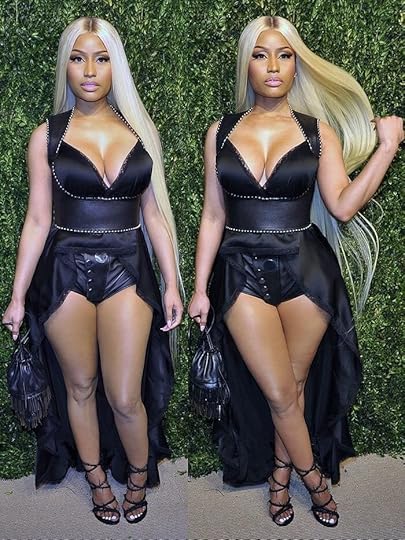
Nicki Minaj at the 2017 CFDA/Vogue Fashion Fund Awards in custom Alexander Wang (Getty Images)

Nicki Minaj
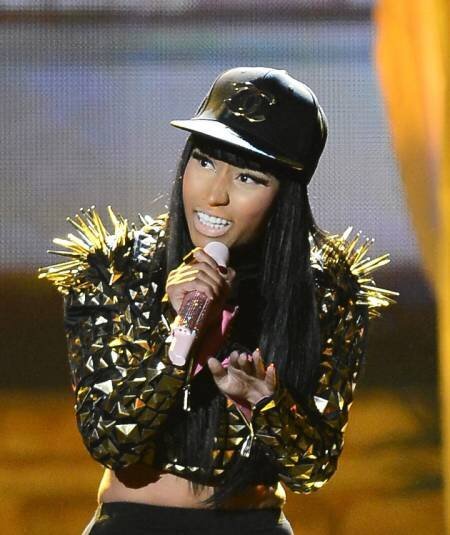
Nicki Minaj at the 2013 Billboard Music Awards in Frankie Morello
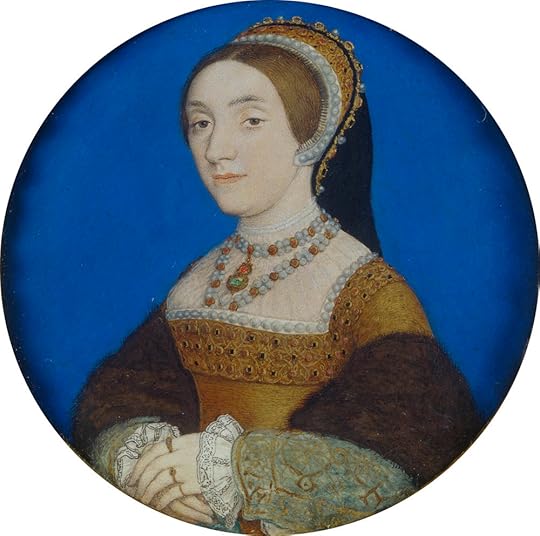
Portrait of a Lady, perhaps Katherine Howard, circa 1540, watercolour on vellum, by Hans Holbein the Younger
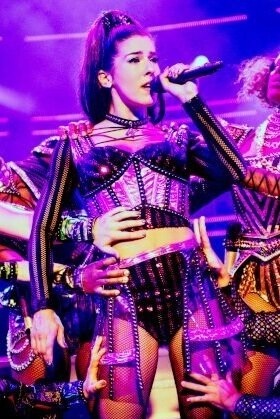
Katherine Howard (Aimie Atkinson), Photo by Idil Sukan.
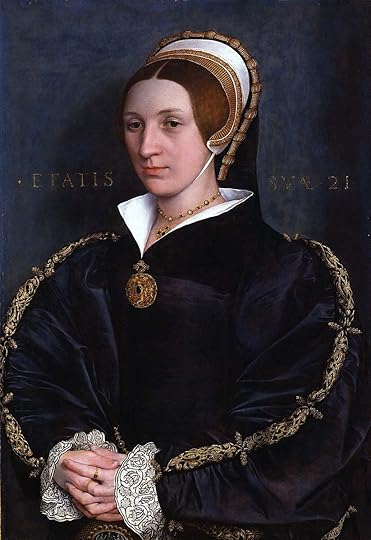
Portrait of a lady, probably a member of the Cromwell Family (formerly identified as Catherine Howard), ~1535-1540, oil on panel, By Hans Holbein
Prick up your ears,
I’m the Katherine who lost her head
For my promiscuity outside of wed-
Lock up your husbands
Lock up your sons
K Howard is here
And the fun’s begun
Catherine Howard (Queen from July 1540-November 1541) was a member of the illustrious aristocratic Howard family and Anne Boleyn’s first cousin. Her immediate family however, was not wealthy and her father often had to beg for handouts from his rich relatives. Her mother had five children with her first husband and then had another six with Catherine’s father; as one of the youngest children, Catherine was likely not her parents’ top priority.
After her mother’s death when Catherine was about 5 years old, she was sent to live with her father’s stepmother, the Dowager Duchess of Norfolk, along with several of her siblings. Although it was common for noble families to send their children to be trained in other noble households, the Dowager Duchess’s household was somewhat notoriously lax and undisciplined. It is reported that the children there ran a little wild; several of the older girls there entertained male visitors in the girls’ dormitory at night, receiving gifts in return.
Catherine could read and write but was not as well educated as many of Henry’s other wives. She was apparently quite vivacious and giggly. At age 13, her 36-year-old music teacher Henry Mannox molested her repeatedly. Once she was moved to a different house at 15, she allegedly took Francis Dereham (who was at least 28), one of the Duchess’s secretaries, as her lover. They referred to each other as husband and wife and Catherine kept track of Dereham’s money for him while he was away on business. This relationship was apparently common knowledge among many of the Duchess’s maids of honor and attendants. However, the Dowager Duchess of Norfolk put a stop to it when she discovered it.
Later, her uncle, the influential Duke of Norfolk Thomas Howard, obtained a place for her in Anne of Cleves’ household, where she served as a lady-in-waiting. Henry met her there and became a bit infatuated, claiming he had never known her “like to any woman” and giving her great gifts of land and expensive cloth. He called her his “very jewel of womanhood,” but the story that he called her “his rose without a thorn” is likely a myth. She married Henry less than a month after his marriage to Anne was annulled. We don’t know her exact age, but she was around 16-17 and Henry was 49, which was pretty elderly for the time. At this time in his life, Henry was obese and had developed very painful ulcers on his legs; he had a bad temper and often took it out on his councilors.
Unlike the baseless claims for Anne Boleyn’s “affairs,” Catherine Howard’s sexual activities both before and during her marriage are pretty well documented. She became involved with one of Henry’s favorite courtiers Thomas Culpeper, who called her “my little sweet fool” in his love letters. Catherine’s lady-in-waiting Jane Boleyn, Lady Rochford (George Boleyn’s widow), apparently assisted with their secret meetings throughout a royal progress. At the same time, people who knew of the situations with Dereham and Mannox began to blackmail her for her silence; she may have appointed some of these to her royal household.
It was really through behind the scenes rumors and gossiping that Catherine met her downfall. Allegedly, a fairly random man named John Lascelles tried to get his sister Mary to work for the Queen, but she refused, saying she knew of Catherine’s sexual activities when they both lived together in the Duchess’s household. Lascelles reported this to the Archbishop of Canterbury Thomas Cranmer, who spoke to Mary Lascelles and Lady Rochford while pursuing a case against Catherine. His investigation turned up a love letter from the Queen in Culpeper’s chambers. Henry was probably unaware of the entire situation until he received a warrant of her arrest.
Catherine refused to admit that there was a precontract between her and Francis Dereham, even though that precontract would have terminated her marriage to Henry and possibly saved her life. She was imprisoned in Syon Abbey (which her ghost supposedly haunts to this day). Culpeper and Dereham were both executed; the noble Culpeper by beheading and the commoner Dereham by being hanged, drawn, and quartered. Catherine was later beheaded.
Historical Inspiration: To start off, there’s no evidence that Catherine Howard actually ever sat for a portrait and although many portraits have been identified as her traditionally, there are no authenticated versions. On the Tudor Trail wrote a really interesting blog post about it here. However, the two I’ve shared here are some of the most commonly attributed to be her, so if any inspiration came from a historical portrait of her, it was likely one of these.
However, I’ve had trouble finding really any historical elements or inspiration in this costume. Nothing seems to indicate any clothing or accessories from that period at all, except perhaps the somewhat square shaped neckline and the grommeting, which mirrors the beading in the portraits.

Ariana Grande on her 2015 Honeymoon Tour
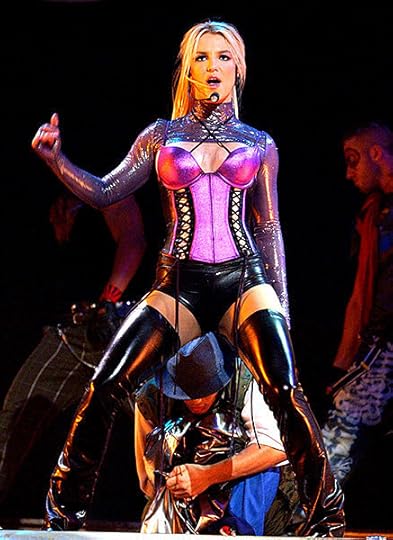
Britney Spears at the 2003 American Music Awards Ron Wolfson/WireImage

Ariana Grande at the 2014 Victoria’s Secret Fashion Show. Photo: Getty
Modern Inspiration: The overall feel of Catherine’s look and song seems to be sexy but really young and naive, which is reflected in the youthful color scheme, hairstyle, and accessories (chokers are very “in” right now). The contrast between the long sleeves and the crop top could be read to signify that she doesn’t necessarily want to be the “sexy” one, but as it’s the only way she’s ever gotten attention or power, it’s what she knows.
The bottom of the outfit is clearly based off of one of Ariana Grande’s signature looks. I could honestly have included about 5 more photos of Grande wearing a similar high-waisted hot pants + skirt flaps, as they are EVERYWHERE. Britney Spears has also been cited as an influence on this character as well; the top is definitely similar to Spears’ 2003 AMA outfit, particularly in the long sleeves, color scheme, and complicated neck decorations.
The hair is also quite clearly based off of Ariana Grande’s signature look. Grande had to bleach and dye her hair intensely for three years while playing a character on a TV show and apparently it really messed up her hair, so for a while, a ponytail was the only look that really worked for her. She continues to wear it that way pretty often. The high pony and pink tips emphasizes how young and naive Catherine was and how much that affected her decisions and life. Britney Spears also wore her hair in ponytails/pigtails a lot when she was very new in her career, so it also ties into the “pop princess” feel of Catherine.
“All You Wanna Do” is a classic pop princess song that sounds a lot like Britney Spears. In particular, it has a really similar melody “If You Seek Me,” and shares a similar theme of “everyone sees me as a sex symbol” (although the song from Six is much darker). It’s the one I’ve seen reviewers cite most often as one of their favorites, I think because it’s such a perfect match of song style to character. Many pop stars started out as young, naive teenagers just like Catherine Howard and quickly found themselves in over their head as they were endlessly sexualized by society and by the people around them. The end of the song also defies the expectations set out by the braggadocio beginning - “I think we can all agree I’m the ten amongst these threes…And ever since I was a child I made the boys go wild” with the overwhelmed and desperate “I thought this time was different, Why did I think he’d be different, But it’s never, ever different.”
Accessories Note: It appears from photos that the only two queens in the show with choker necklaces/choker style necklines are Anne Boleyn and Katherine Howard, who were both beheaded. True, their historical portraits also contained chokers, but if you look closely, you’ll realize that ALL of the queen’s historical portraits shows them wearing choker-like necklaces (I guess the look was just really popular then?), so the decision to have only Boleyn and Howard wear them seems pretty deliberate. The two women were also cousins and are the only queens to sport their initials on their necklaces. While Anne’s “B” is in her historical portrait, I think Katherine’s “H” symbolizes her familial connection to Anne Boleyn and their similar downfalls and deaths.
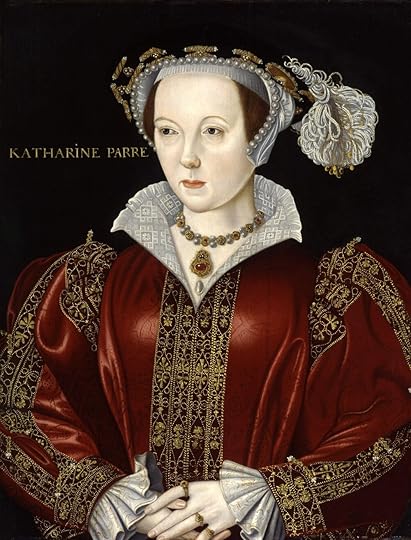
Katherine Parr, by an Unknown artist. Oil on Panel, late 16th century.
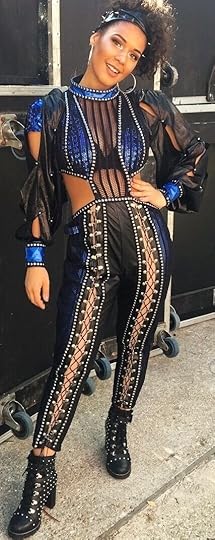
Catherine Parr (Maiya Quansah-Breed - West End)
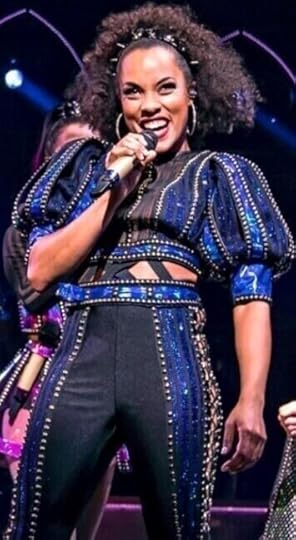
Catherine Parr (Anna Uzele - Chicago) (Photo by Liz Lauren)
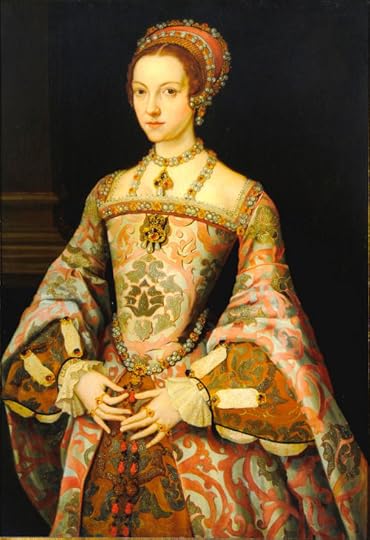
Catherine Parr, seventeenth-century copy of a sixteenth-century original
Five down, I’m the final wife
I saw him to the end of his life
I’m the survivor, Catherine Parr
I bet you wanna know how I got this far
Catherine Parr (Queen from 1543-1547) was Henry VIII’s last Queen and the last queen consort of the House of Tudor. She holds the record for the most-married English queen and had four husbands in her life.
Catherine was actually the daughter of one of Katherine of Aragon’s ladies-in-waiting, Maud Parr, and Katherine herself served as her godmother. She was highly educated and fluent in French, Latin, and Italian. She married Sir Edward Burgh when she was 17; he died four years later.
Her second husband, John Neville, Baron Latimer, was twice her age and a strong supporter of the Catholic church. He opposed Henry VIII’s first annulment and marriage to Anne Boleyn. However, when Catholic rebels rose against the king in 1536, they threatened violence unless Latimer joined them. Catherine and her step-children lived alone without Lord Latimer for many months, during which time they were taken hostage. The rebels ransacked their house and sent word to Lord Latimer that if he did not return immediately, they would kill his family. Fortunately, he successfully talked the rebels into releasing his family and letting them leave. Latimer later had to formally condemn the rebels and submit to the king’s clemency to ensure that he would not be found guilty of treason. This damaged Latimer’s reputation and forced the family to stay away from the royal court for many years; he was later blackmailed by Henry’s chief minister Thomas Cromwell and forced to do his bidding. However, after Cromwell’s death, the family was able to return to London. This is when Catherine became acquainted with her future fourth husband, Sir Thomas Seymour.
After the death of Lord Latimer, Catherine joined Lady/Princess Mary’s household, where she attracted the king’s attention. Although Catherine had become romantically involved with Seymour, when Henry proposed, she accepted. Henry then conveniently gave Seymour a job which moved him to Brussels. During their marriage, Catherine became close to all three of Henry’s children. She was also the second of Henry’s queens to rule as regent while he was away in France on campaign (the first was Katherine of Aragon).
However, Catherine held strong Protestant views that several Catholic officials viewed with suspicion. She sometimes debated religious issues with Henry, to the king’s annoyance. Though some of Henry’s officials tried to turn the king against Catherine and get her arrested, Catherine managed to see the arrest warrant beforehand and reconciled with the King by vowing that she had only argued with him about religion to take his mind off the pain from his ulcerous leg. The following day, an armed guard tried to arrest her while she was with the King, but Henry dismissed him angrily. In her life, she wrote and published three religious books: Psalms (anonymously) “Prayers or Meditations” (the first book published by an English queen under her own name), and “The Lamentation of a Sinner.”
Only six months after Henry’s death, Catherine secretly married Seymour (who had already proposed or made advances to Princess/Lady Mary and Princess/Lady Elizabeth because he was a gigantic cad). Seymour later was known to make several inappropriate physical advances toward the 13-year-old Princess Elizabeth while she was living with him and Catherine; Catherine eventually had to send her away. Again, he was a gigantic cad. After Catherine died, Thomas Seymour tried to kidnap the young king Edward and shot his dog in the process. He was beheaded for this, naturally.
ANYWAY - back to the story at hand. King Edward VI (Henry’s young son) and the ruling council were not informed of Catherine’s marriage to Seymour for several months. Once it became common knowledge, everyone was pretty annoyed at the quick and secretive marriage; they were publicly censured and reprimanded by the ruling council and both the king and Lady/Princess Mary were vocal in their disapproval of the union. Somewhat surprisingly, given that she had not conceived during her first three marriages, the 35-year-old Catherine became pregnant by Seymour. However, she died a few days after giving birth to a daughter, Mary Seymour. Mary doesn’t show up in records past a certain point, which makes historians believe she died before she was two.
Historical Inspiration: Parr’s costume in Six has a few elements in common with her historical portrait; the inspiration is particularly obvious in the puffy sleeves, stripes, high collar, and highly visible shirt cuffs. The spiked hairband seems to emulate the beaded hood in the portrait. In addition, both actress’s hair is voluminous in a way that is loosely reminiscent of the feather on the hat in the portrait.
Catherine Parr is the only queen to wear pants in the show. This may refer to Parr’s forward-thinking, powerful views and her unusual outspokenness, as she’s literally wearing “the pants.” Additionally, Parr’s feather-topped beret in her portrait was of a style also commonly worn by men; I don’t believe any of the other queens are painted wearing any similarly androgynous style. I imagine the pants could also be pointing to that. The laces in the pants are probably a tongue-in-cheek reference to the lacings on renaissance women’s dresses and corsets.
I’ve shared both the West End and the Chicago versions of the costume here because I couldn’t find a good performance photo from the West End. As you can see, though the costumes are similar, there are a few key differences, most obvious in the amount of skin shown.
Modern Inspiration: Alicia Keys commonly wears pants and tops with voluminous sleeves. She’s also been seeing wearing stripes on numerous occasions. The blue in Parr’s costume could also refer to Alicia Keys’ R&B style, which stands for “Rhythm & Blues.”
The song itself “I Don’t Need Your Love” is stylistically very classic R&B, with smooth, lush vocals laid over synthesizer chords. The verses overall are more conversational and longer than in many of the other queens’ songs. The use of “boy” in the lyrics also is reminiscent of many R&B songs, particularly Alicia Keys’ “Diary.”
It appears that the beginning verse actually is speaking to Thomas Seymour, who Catherine loved; however, when the king proposed, she pretty much had to accept him, so her marriage to Seymour was delayed for several years. Thus, the first chorus of “I don’t need your love, no, no” is her trying to talk herself into letting Seymour go, the second chorus is her imagining what she’d say to Henry VIII if she was able to actually refuse, and the final chorus is her joining with the other queens to state that they are people in their own right who don’t need Henry or his love, which brings the musical toward its end in a strongly feminist way.
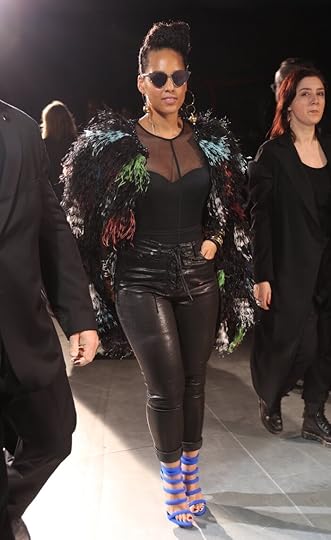

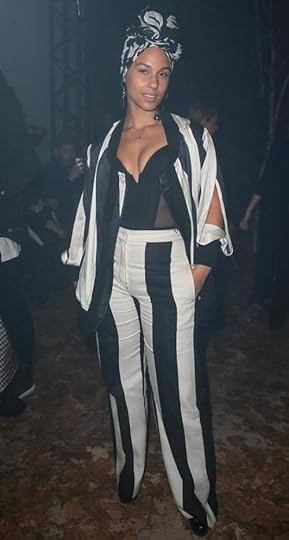
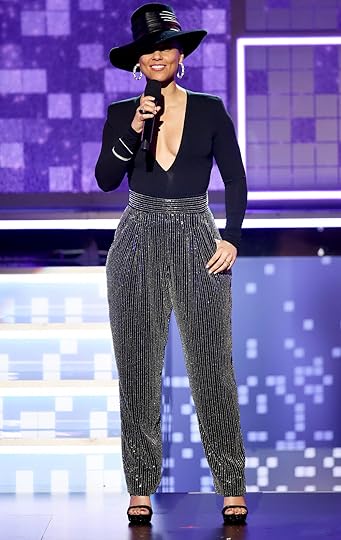
So that’s it for now! I plan to write future blog posts on the alternates’ costumes and on how the costumes have evolved and changed over time. : ) Thanks!
October 23, 2019
I met Philippa Gregory and Margaret George at the National Book Festival!
So the National Book Festival was in friggin AUGUST and I still haven’t posted these pictures of me with some of my favorite authors up anywhere so here, here they are finally.
I went to see Philippa Gregory really, but I was delighted to realize that I knew the other author on the Historical Fiction panel as well: Margaret George! She wrote a wonderful book called “The Autobiography of Henry VIII” that I read years ago and really loved; it’s one of the very few books I’ve ever read that chronicles Henry’s life from beginning to end and it offered a great POV that I really appreciated. I still often think of it when I’m learning about Henry VIII in different contexts.
It was really inspiring to hear them discuss different aspects of their work; I basically want to be them when I grow up so I’m really happy I got to hear them talk!
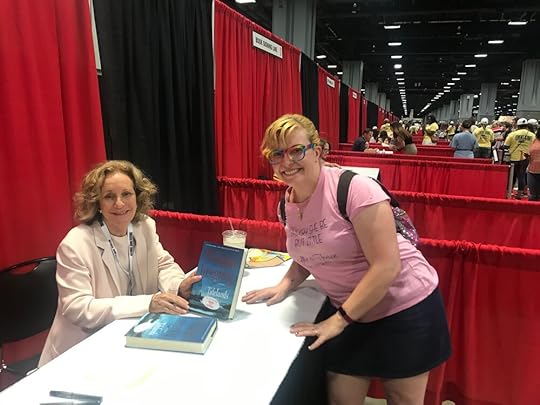
Me with Philippa Gregory, getting my Tidelands book signed!
Various quotes and tidbits: (these are from my notes and are as accurate as possible, but I was taking them rather quickly so there may be some errors)
Research:
Margaret George and Philippa Gregory both said they prefer to visit the places in which the events of their books occurred if possible.
PG: “Research is really just lots of reading. Which is a good thing to say at a book festival. Some people think there’s a secret trick like you go talk to people and they tell you everything but no, it’s really just reading.”
How their books relate to modern issues:
MG said Nero is oddly a modern character. “He wanted to be an artist - but instead he had to be an emperor- so many people had died to make him emperor that he couldn’t really say no, I want to go be an artist.”
PG: “[The presence of modern issues in my books] is not intentional- but I can’t shut the door on it- the whole idea is to have a window onto history - just by reading my book you can tell I’m from Sussex university in the 1980s. You can’t escape your own consciousness…. I try not to be anachronistic in any way, I try not to drag in politics like a cat dragging in a dead bird, like ‘because I’m interested in this you must be in it.’”
MG: you can date movies by the time period they’re filmed in- from their makeup and hair, etc - books are the same.
Moderator: that’s why historiography is so interesting - likes to see what other people on the past thought of their history and how that informed their lives
Interesting things about their characters:
MG: Nero wasn’t even there at the Fire of Rome. But people at the time said he was performing his ode to the fall of Troy (he had a thing about Troy), and they said the backdrop was just too much to resist, so he would go play it there. But it bothered him because the truth was the opposite. The common people loved Nero!
Tacitus said wild improprieties - it was really just chariot riding and acting. Nero couldn’t get an honest judgment at the time whether he was really any good as an artist. So we can’t get an honest answer in modern day either.
Only 4 lines of his poetry survived. None of his music. Golden house survived but that’s it - it’s the only proof we have of his artistic talent
PG: The extent of the way women were treated in medieval society - that Henrietta Maria (queen of Charles I) - she was catholic so English schools had taught against her - she was very authoritative and bossy with her . “We don’t like bossy little women, which is a pity, since many of us are.” /laughs, claps/
Has a reputation as a bad adviser. What I didn’t know- she landed in England under cannon fire with her army and marches around England as a queen militant. She was far more courageous and enterprising than history books say. The slight bias of history- how it obscures some really interesting women.
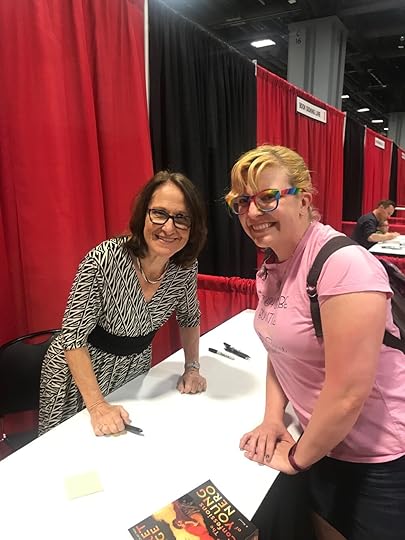
Me with Margaret George, getting my Confessions of Young Nero copy signed!
Why PG switched from writing about royalty to writing about a commoner (in Tidelands):
I wrote by royalty very much as an accident. What I was interested in was women in history and you can only find out about women in history if they’re around important men. Eg we don’t know Anne Boleyn’s birthday. There are so many women of just such huge interest who played such a big role in English history that we only know about if they’re associated with the king- etc - Elizabeth Woodville (know she’s with the king or pregnant). Mary Boleyn- led to interest in Catherine- to MIL Elizabeth Woodville, And then 20 years later you look up and find yourself an expert on English royalty and I am by character and interest anti-monarchy.
And people ask me about royal weddings and such and Reaky, they’re just very boring. I’m interested in tyrants really, the boleyns and the Tudors and the Plantagenets bit when you get to the Windsors, just not really interested
For her Midwife character: got a lot of records from criminal trials for witchcraft (which aren’t necessarily content-helpful because it’s about men saying why she’s a witch) all the evidence at the trial is truly male sexual fantasy and fiction but it GIVES you information about these women who were tried and then unfortunately burned
In Tudor Times there were women harvesting gangs that would harvest and drink and it sounds like a good party. Well that had to go away as nobles enclosed more and more of the land. There was growth of the idea that poverty shouldn’t be resolved by individual gifts but in an organized way. You can’t just go knock on your neighbor’s and ask for help now, have to go apply for help- it was very alienating.
Setting- the tides in and out, sets the entire course of the day. Tide mills - operates as a usual mill but it runs based on the tide - used to be hundreds of them. Now there are only 2 - went to one and talked to the miller and had one of the most comical conversations ever in researching a book. “If you were going to put a woman on the wheel to say, drown her, how would you do that?” Looked at her in horror and said “Nobody has ever asked that” “well how would you” “well how heavy is she?”
MG: Agrippina was a huge driver of Nero’s life. He fell in love with a freedwoman in youth and wanted to marry her, friends his entire life, willed her things, she held Nero’s funeral. In Rome, women had no political office, so they were strong behind the scenes, but they were not allowed in public life.
Compared Nero to The Godfather _ dark side etc (her feelings, not historical record).
3 sides - son of Augustus/young emperor, artistic side, dark side who made the other two possible
Nero’s coinage is really considered super beautiful. The coins show his face changing as he gains weight and gets a double chin
A lot of the judgment about him was around the time - emperor Hadrian had a lot in common with him and we love him- but that occurred 50-60 years later. MG compares their respective reputations to the way we talk about same sex marriage and race now versus 50-60 years ago.
What do you want readers to come away with?
PG: It makes her happy when readers are inspired to study history after reading her novel. She wants her readers to like the novel and say it’s good really. Some people reflect on their lives and such. But really I want them to think it’s a good book and then buy the next one.
MG- going for a Shakespearean tragedy feel of “woe and wonder.”
Q&As:
Is it harder to write dialogue of historical people or composite fictionalized people?
MG: Finds it easier to do historical, sine you have a record, and know what they might say.
PG: with a known character, it can be lovely to weave their real speech in there if you can. Plus most of what people think they know about historical women is incorrect- she enjoys taking on well known women and being out new sides of them.
MG feels same way
Queer or LGBT people portrayals?
MG- Nero dresses up a guy as his dead wife (maybe more of a grief and necrophilia thing)
PG- there isn’t enough historical research yet on the subject for her to include it in her books. Thankfully it’s being done now. Plus, it’s hard to know what is lesbian behavior in historical books like, women sleeping in the same bed together in Jane Austen. There’s no intercourse- but why is intercourse the standard of a romantic relationship?
How they respond to critics that say book is historically inaccurate:
MG: tries to use the sources that are most reliable
PG: if someone tells me I did something wrong, like someone landed in the wrong place- I alter it in next edition. And send them a signed book as a thank you
If they say it’s wrong and it’s right I just grind my teeth.
Research organization?
MG- uses note cards , once you have a cohesive story line, easier to lay out
PG- files and books and such. But it’s the stuff that sticks in the mind that makes the story. As a novelist, you shouldn’t gift the reader your hours and hours of tedious study. They can do that if they want.
Love of history or writing first?
MG- First did writing.
PG- loves writing but also loves history. “I’m so blessed to be able to work in a genre that combines the two. I can’t imagine having one without the other .”
October 21, 2019
My Obsessive Shakespeare English History Play Family Tree (from Richard II, Henry IVs, Henry V, Henry VIs, and Richard III)
Things I should have blogged about today: Six the Musical costumes (still working on it!), things I learned at the Emerging Writers Festival, the authors I met at the National Book Festival, TudorCon (just got back!), More #ShakespearesPlaylist
Things I actually worked on today: An overly detailed family tree of English monarchs involved in the Hundred Years’ War and the Cousins’ War (also known as the War of the Roses), as portrayed in various Shakespeare plays, including Richard II, Henry IV Part 1 and 2, Henry V, Henry VI Part 1, 2, and 3, and Richard III. This started as a way for me to sort out my own thoughts and for eventual distribution to the cast members of the Richard III production for which I’m stage managing, but it may have gotten a little too obsessive to be helpful at this point, lol.
[image error]
I started with the wonderful family tree over at The History of England Podcast website (Thank you very much!) and modified it in a lot of ways, erasing some descendants that aren’t mentioned in the plays or super relevant, adding in others that are, etc. I also added in various notes to indicate “who killed whom” (or was ultimately responsible for the death) according to Shakespeare and “who had an affair with whom” (according to Shakespeare or historical fact or rumor). [NOTE: a lot of these deaths and affairs are not at all confirmed in history and I am in no way saying it actually happened that way, don’t at me.]
My conclusion is that everyone’s related (thus, the cousins’ war!), no one has ANY IMAGINATION WHATSOEVER when it comes to naming, and everyone killed everyone else’s relatives in some way.
Did I miss someone important? It’s totally possible! Half of these people have the same damn names!
Shakespeare has a whole bit in Richard III Act IV Scene 4 poking a little fun at that. I’ve put in notations to indicate which one is being talked about at which point because it is DAMN CONFUSING.
Queen Margaret. (speaking to Elizabeth Woodville)
Tell o'er your woes again by viewing mine:
I had an Edward (Edward, Prince of Wales [son of Henry VI and Margaret of Anjou]), till a Richard kill'd him; (Richard, Duke of Gloucester/Richard III)
I had a Harry (Henry VI), till a Richard kill'd him: (Gloucester/R 3)
Thou hadst an Edward (Edward V [son of Edward IV and Elizabeth Woodville]), till a Richard kill'd him; (Gloucester/R 3)
Thou hadst a Richard (Richard, Duke of York [son of Edward IV’s and Elizabeth Woodville), till a Richard killed him; (Gloucester/R 3)
Duchess of York. I had a Richard too, and thou didst kill him; (Richard, Duke of York [father of Edward IV, Clarence, and Gloucester/R 3; also Duchess of York’s late husband])
I had a Rutland too, thou holp'st to kill him.
Anyway, If I DID miss someone or got something wrong in this family tree, please let me know; it would be most appreciated!
October 10, 2019
Mental Health Awareness Day
Today is Mental Health Awareness Day. 1 in 5 adults in America experience a mental illness and nearly 1 in 25 live with a serious mental illness. However, there is still a significant stigma toward mental illness in our society. We’re not supposed to talk about it. People experiencing mental health conditions often face rejection, bullying, and discrimination. I myself have experienced this before. This stigma can prevent people from reaching out for help and can sometimes have fatal results; Suicide is the second leading cause of death of youth ages 15-24 and the tenth leading cause of death for all Americans.
I live with depression and ADHD (and probably a bit of undiagnosed anxiety, tbh). Though these conditions are mostly controlled, they have had a huge impact on my life in the past and continue to do so now. They’re part of me, and I’ve chosen to embrace them and talk about them openly to help combat that stigma and help others. I’m happy to talk about these things and if you ever need someone to talk to, please reach out!
Resources:
The World Health Organization also has a great video series on what you can do to help prevent suicide.
The National Alliance on Mental Illness has a whole page on fighting stigma and helping those with mental illness; I highly suggest you read it.
NAMI also has a whole bunch of initiative and guides on their Mental Illness Awareness week page.
https://www.nami.org/get-involved/awareness-events/mental-illness-awareness-week
October 7, 2019
#ShakespearesPlaylist: Twelfth Night
So I LOVE finding songs to fit the mood of #Shakespeare plays. Basically every time I hear a song I love on the radio, I think about how I could fit it into a production. I can’t help it. My brain just does that, which is funny, because I’ve only directed one production (my own one-act) and questioned myself and my abilities the entire time, so I don’t necessarily see myself directing anything else any time soon, but I just like to dream about the music anyway.
I’ve decided to play with this habit of mine more and make full-fledged Spotify and Youtube playlists for each play by Shakespeare, under the umbrella name and hashtag #ShakespearesPlaylist .
So Twelfth Night has long been one of my favorite Shakespeare plays (like, since age 10) and I’ve performed in it twice myself, so the summary and song list in this post are longer than any I’ve written so far in this series! I just can’t help myself, I really love this play, hah.
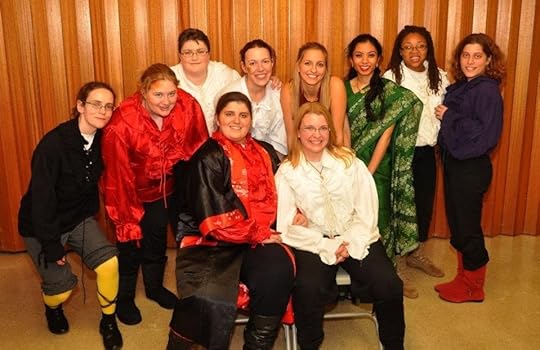
The Britches and Hose Production of Twelfth Night in 2011. I was Viola!
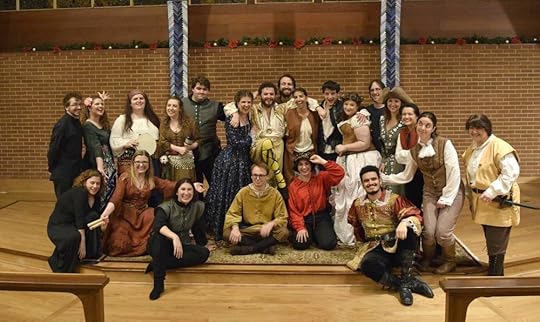
The Britches and Hose Production of Twelfth Night in 2017. I was a wandering singing musician person - we called ourselves the Festettes!
Quick Wikipedia Summary: Viola is shipwrecked on the coast of Illyria. Believing that her twin brother Sebastian is dead, she disguises herself as a young man under the name Cesario and enters the service of Duke Orsino. Duke Orsino has convinced himself that he is in love with the noble lady Olivia, who is mourning the recent deaths of her father and brother and refuses to see any men or entertainments. Duke Orsino then uses 'Cesario' as an intermediary to profess his passionate love before Olivia. Olivia, however, falls in love with 'Cesario', setting her at odds with her professed duty. In the meantime, Viola has fallen in love with Duke Orsino, creating a love triangle: Viola loves Duke Orsino, Duke Orsino loves Olivia, and Olivia loves Viola disguised as Cesario.
In the comic subplot, several characters conspire to make Olivia's pompous steward, Malvolio, believe that Olivia has fallen for him. This involves Olivia's riotous uncle, Sir Toby Belch; another would-be suitor, a silly squire named Sir Andrew Aguecheek; her servants Maria and Fabian; and her melancholy fool, Feste. Through a fake love letter, Malvolio is encouraged to make a fool of himself in front of Olivia, who is convinced that he is mad and leaves him to be cared for by his tormentors. Pretending that Malvolio is insane, they lock him up in a dark chamber. Feste visits him to mock his insanity, both disguised as a priest and as himself. Sir Toby later marries Maria for this jest. When Malvolio is finally released, he swears revenge on all who conspired against him.
Meanwhile, Viola's twin, Sebastian, has been rescued by Antonio, a sea captain who previously fought against Orsino, yet who accompanies Sebastian to Illyria, despite the danger, because of his admiration for Sebastian. Sebastian's appearance adds the confusion of mistaken identities to the comedy. Taking Sebastian for 'Cesario', Olivia asks him to marry her, and they are secretly married in a church. Finally, when 'Cesario' and Sebastian appear in the presence of both Olivia and Orsino, there is more wonder and confusion at their physical similarity. At this point, Viola reveals her identity and is reunited with her twin brother. The play ends in a declaration of marriage between Duke Orsino and Viola.
I chose “Hey Brother” by Avcii to demonstrate the familial love between Viola and Sebastian. Both of them believe the other has drowned in the crash and are pretty devastated about it. The chorus in particular fits this storyline:
What if I'm far from home?
Oh brother, I will hear you call!
What if I lose it all?
Oh sister, I will help you out!
Oh, if the sky comes falling down, for you
There's nothing in this world I wouldn't do
Amy Winehouse’s cover of “To Know Him is to Love Him” is a perfect illustration of Viola’s love for Duke Orsino.
To know know know him
Is to love love love him
Just to see that smile
Makes my life worthwhile
Why can't he see?
How blind here he be?
Someday he'll see
That he was meant just for me, oh oh oh oh
Taylor Swift’s “You Belong with Me” also represents Viola’s situation, simultaneously in love with Orsino but pretending to be his male friend, having to woo another lady on his behalf. It’s so bubblegum pop that I really resisted including it in this list, but honestly, the lyrics are so ridiculously perfect for this plotline that it had to happen.
If you can see I'm the one who understands you
Been here all along so why can't you see
You belong with me
You belong with me
Walkin' the streets with you and your worn-out jeans
I can't help thinking this is how it ought to be
Laughing on a park bench, thinking to myself
Hey isn't this easy
And you've got a smile that could light up this whole town
I haven't seen it in a while since she brought you down
You say your fine
I know you better then that
Hey what you doing with a girl like that
…I'm the one who makes you laugh
When you know you're about to cry
And I know your favorite songs
And you tell me about your dreams
I think I know where you belong
I think I know it's with me
I’ve chosen Carly Simon’s “You’re So Vain” to represent Malvolio, who is so overproud that he willingly believes his mistress Olivia is in love with him, despite the ludicrousness of the fake love letter and the situation as a whole. He literally thinks the letter is about him!
You're so vain
You probably think this song is about you
You're so vain,
I'll bet you think this song is about you
Don't you? Don't you?
I chose Mad World by Gary Jules to represent Sebastian’s massive confusion about arriving in Illyria. Everyone seems to know him and have strong opinions about him, but he just got there! What the heck is going on. (I’m not so certain on this choice, as I think the overall mood of the song is too melancholy for Twelfth Night, but I really want something in here about Sebastian’s POV. I may replace this one later if anyone has any good suggestions!)
The Lumineers’ “Hey Ho “is a great song to represent Feste, as Feste’s song in the show literally includes the words “Hey Ho, the wind and the rain.” Plus, the laid-back troubador style of Hey Ho works really well for Feste’s casual and humorous approach to life.
Finally, here’s a video of an actual production of Twelfth Night which I actually was in. It’s the final song in the show, The Rain it Raineth, with music by Dave Seidman-Joria. Feste in this version is played by Sam Stenecker! Then from left to right in the back is: Lauren Sutton, Leandra Lyn, Megan Fraedrich, Rachael Dickson (my non-writing superhero alter ego), and Dan Clark.
A Cell Phone Mount that Actually Lasts- Thanks to Sugru!
I don’t know about y’all, but I have never found a store-brought car cell phone holder that actually lasts for any significant amount of time. Whether they clip on to an air vent, stick on to the dash, or suction on to the windshield, they always fall within a few days to a few weeks. I often resort to sticking my phone in the drink holder so I can reference directions when I’m going somewhere new. But with my arthritis neck joints, this can be really painful. I also have to take my eyes off the road much more if I do this.
My grandparents recently gave me their old 1997 van; I have a car for the first time since February (my previous car was totaled after a tire blew out while I was driving on a highway. Fortunately, no one was hurt, just my car)! I optimistically bought a clip-on phone holder at the auto parts store when i was picking up some new windshield wiper blades and it fell down within 5 minutes. It was frankly just ridiculous.


Fortunately, I’ve found a solution! Sugru is this really cool clay like substance that is sticky and moldable at first, starts solidifying after thirty minutes, and is cured hard and strong in 24 hours! I used this to make a cell phone mount in my previous car too and it stayed put for over half a year. It lasted through my car accident and was still there when I sold the car to my insurance company.
It’s pretty easy to create this phone mount. I took the case off my phone and molded the Sugru around it. This gave me the exact dimensions I needed but was light enough that it didn’t mess up the Sugru while I was working with it.
I positioned the mount as close to my sight line as I could. Here, my phone is held firmly in place and is visible right over the right side of my steering wheel. It’s a non traditional area for it, but it works great.
[image error]
Sugru Moldable Glue - Original Formula - Classic Colours 8-Pack - SMLT8
I ended up using two packages of Sugru for this. I molded two holders under the phone, for it to sit on, and a holder on each side, to hold it in the right spot, sticking each holder solidly to the dash as I worked. You have 30 minutes to work with the Sugru before it starts setting, but I actually put this all together in just 5-10 minutes. I then let it cure for the next 24 hours and voila- a stable, solid, working cell phone mount!
It’s not the /prettiest/ mount out there, but it works perfectly for my needs.
Have you used Sugru? What problems did you fix with it?
October 3, 2019
Tech and Safety Tip: Sending your Location to Friends via iPhone or Messenger
I read a comment somewhere online the other day that mentioned an iPhone feature where you can text your exact location to a friend. I didn’t know this existed, but I am so happy it does! This not only will make meetups at big festivals easier, it’s a great safety tip!
I’ve had to walk around alone at night before, particularly when I lived in Chicago in the pre-Lyft era, and this feature would have been really handy then! My friends and I already text our taxi or Lyft drivers’ info to each other if they’re acting creepy or driving in a scary way; I love that now I know how to quickly send my location to friends in case of an emergency!
I sat down and figured out how to do it via text on iPhone and via Facebook messenger. It was really easy! Here are some step by step screenshots:
Facebook Messenger:
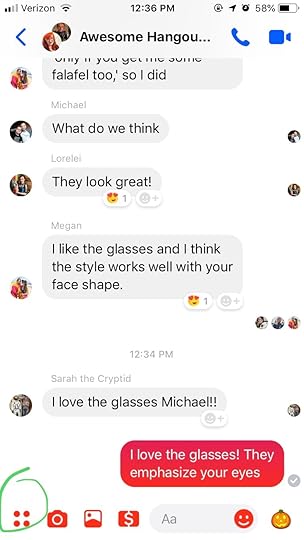
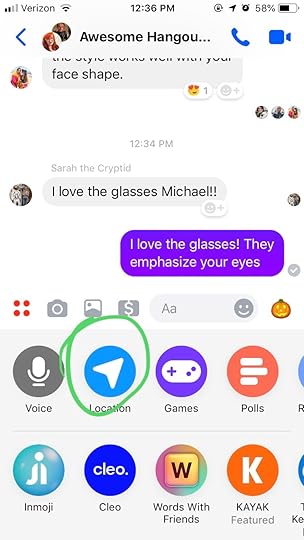
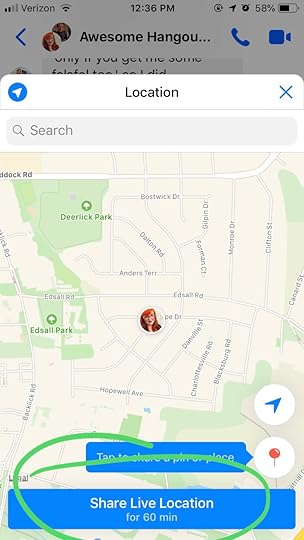
I have a mass group convo with a lot of theater friends, so I tested this out in our chat the other day. It’s just three quick button clicks- first the four dots in the lower left corner of the screen, then the blue and white location button, and finally the “share live location” button. I particularly like that this gives you a live location, so even if you move around, your friends can see where you’re going.
Though iPhone GPS can be a little off at times, a general whereabouts is certainly a lot better than no info at all!
iPhone Texts

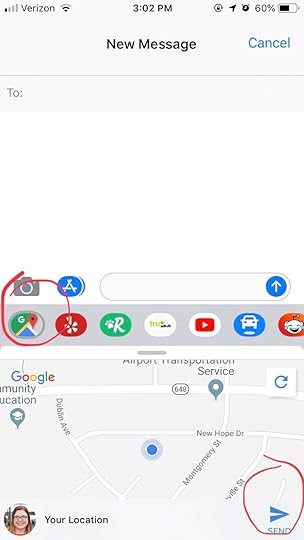
This one’s even simpler! Just click on the google maps button in the bottom right hand of the texting screen and then press “send!”
There’s also an alternate method where you click on a contact’s name and choose to either “send my current location” or “send my location.”
With “send my location” you can actually choose a duration. So if you always want this person to know where your phone is, that’s an option. Or you can just send it for an hour or a day. Choices!


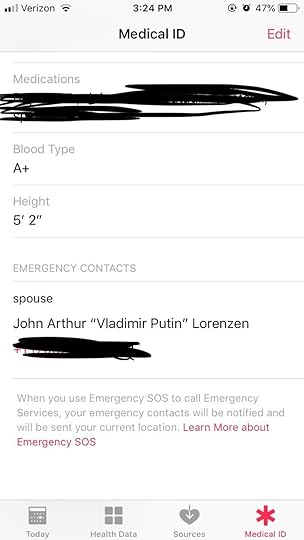
BONUS IPHONE SAFETY TRICK:
If you ever need to call emergency services immediately, push your side button 5 times rapidly and this screen will pop up. Supposedly it works with the home button too, but I couldn’t get it to work.
As Apple says: “hen you make a call with SOS, your iPhone automatically calls the local emergency number. In some countries and regions, you might need to choose the service that you need. For example, in China mainland you can choose police, fire, or ambulance.
You can also add emergency contacts. After an emergency call ends, your iPhone alerts your emergency contacts with a text message, unless you choose to cancel. Your iPhone sends them your current location, and, for a period of time after you enter SOS mode, it sends updates to your emergency contacts when your location changes.”
You can set up your emergency contacts and your medical ID info in the Health app on the iPhone. I don’t use this app for anything else, but it’s useful for this situation.
and there you go! I hope this info helps!
September 30, 2019
The Historical and Modern Inspirations in the Costumes of Six the Musical: Wives 1-3
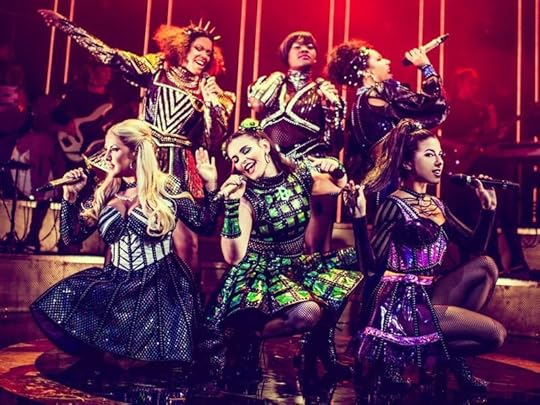
From top left, clockwise - Catherine of Aragon (Jarneia Richard-Noel), Anne of Cleves (Alexia McIntosh), Catherine Parr (Maiya Quansah-Breed), Catherine Howard (Aimie Atkinson), Anne Boleyn (Millie O’Connell), Jane Seymour (Natalie Paris). (Idil Sukan, the West End cast).
You can find the post for Wives 4-6 right here .
So I’ve gotten pretty obsessed with the musical Six lately, which is based on the lives of the six wives of Henry VIII. It’s set up as a girl group pop concert, in which the six women each sing the stories of their lives.
I’ve been dying for more information about the costumes in the show and haven’t been able to find a ton of information. The costume designer, Gabriella Slade, was nominated for an Olivier award for her work. In one article, she said:
“It was an amazing brief. There needed to be an echo of Tudor fashion, but obviously the contemporary influence of the pop industry. It’s an amazing thing to be able to infuse period costume with contemporary style. Lucy [Moss, writer] had ideas about which pop stars related to which queens. Catherine of Aragon is Beyoncé, Jane Seymour is Adele, Catherine Parr is Alicia Keys, Catherine Howard is Ariana Grande, Anne Boleyn is Lily Allen and Anne of Cleves is Nicki Minaj meets Rihanna.”
Other than that though, I haven’t been able to find a lot about her process or inspiration in designing these costumes. So I decided to look into the costumes myself. I’ll be directly comparing them to their historical counterparts and their modern pop artist inspirations.
These are all just educated guesses (based on lots and lots of reading and photo/portrait examining), but I am by no means a fashion or a pop music expert! If you have any contributions or comments, please send them my way - via the comments here, Twitter (@RachaelDickzen), Facebook (@RachaelDickzenAuthor), or email at Rachael.Dickzen@gmail.com. I’d love to hear what you have to say!
This will be the first of several posts on the costumes in Six. Second post will be Wives 4-6 and the Third will take a look at the alternates’ costumes! I also want to do a post looking at how the costumes evolved over time.
Historical Note: Spelling wasn’t standardized in Tudor times, so you’ll see these Queens’ names spelled a number of different ways.
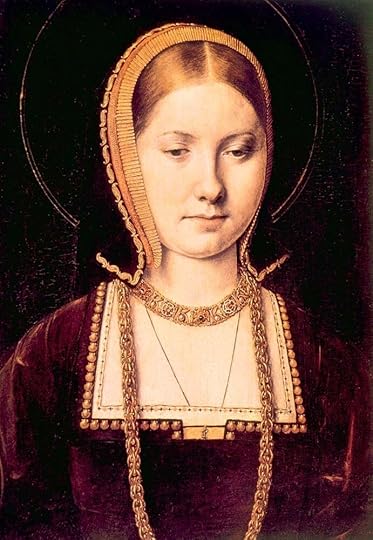
Portrait of a noblewoman, traditionally considered Catherine of Aragon c. 1502 (but also could be Mary Tudor), by Michael Sittow.
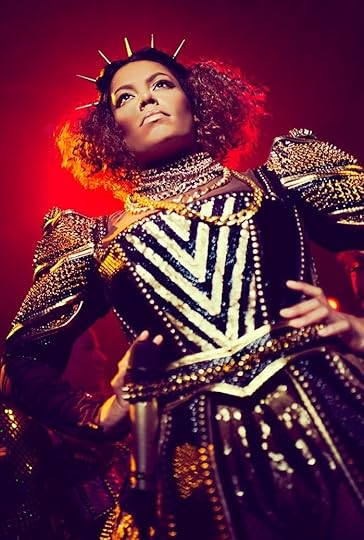
Catherine of Aragon, portrayed by Jarneia Richard-Noel. (Idil Sukan)
My name is Catherine of Aragon
Was married 24 years, I'm a paragon
Of royalty, my loyalty is to the Vatican
So if you try to dump me
You won't try that again
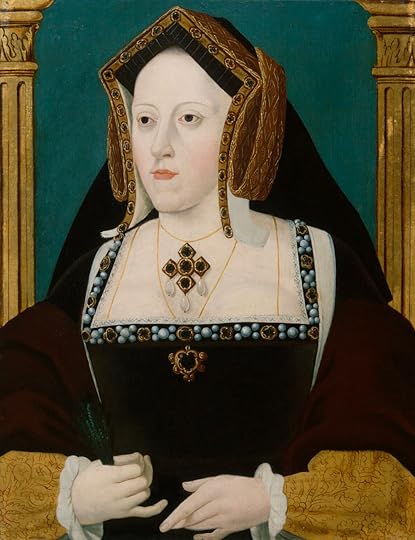
Unknown artist, oil on panel, early 18th century (copy of a lost original portrait)
Catherine of Aragon was a Spanish princess, the youngest child of the famous Ferdinand and Isabella (yes, the same ones who sent Christopher Columbus out on his fun genocidal adventure, but THAT’S another blog post). She was Queen of England from June 1509 - May 1533.
She was betrothed to Henry’s older brother Arthur, Prince of Wales, when she was three years old and married him when they were both 16. However, he died in 1502, only a few months after they married.
What movies/TV shows don’t often tell you about Catherine of Aragon was that she had a HELL of a hard time after Arthur died (The Spanish Princess on Starz got a /bit/ into this, but didn’t fully explore the length of this time in her life. Henry was TEN when she married his brother). By the terms of her marriage contract, if she returned home to Spain, King Henry VII had to return her 200,000 ducat dowry (half of which he hadn’t even received yet). King Henry was broke and totally couldn’t afford this. He briefly considered marrying her himself (after his wife Elizabeth of York died in 1503 after trying to give him another son to replace Arthur), but eventually it was decided that she would marry Henry, Duke of York. However, he was five years younger than her, so they had to wait for him to grow up. His father also continually delayed their marriage. For the next seven years, Catherine lived in near-poverty in London, trapped between her father and her father-in-law. She had to sell many of her goods to survive and was not often seen at court due to the shabbiness of her clothes.
She finally married Henry after his father’s death and his ascension to the throne in 1509. They were married for the next 24 years and for many years, they appeared to be quite in love. Catherine got pregnant seven times but most of her children either miscarried or stillborn; only three survived the birth, and only one, Princess Mary, survived past two months of life. Catherine was always known as a highly intelligent and religious woman, but as more and more of her children died, she became increasingly devout and more interested in academic matters, particularly in ensuring the education of her daughter.
After Henry became obsessed with Anne Boleyn and his all-consuming desire to have a son, he attempted to get his marriage to Catherine annulled on the basis that she was his brother’s wife first. He also asked Catherine to retire to a nunnery. She steadfastly refused all efforts to put her aside and maintained until her death that she was Henry’s rightful queen and wife. Because of her stubbornness, Henry moved her out of his household and into increasingly shabbier and more isolated homes. He also refused to let her see her daughter, Mary. By the time she died in 1535 (probably of cancer), she likely had not seen her daughter for three or so years.
Catherine’s daughter Mary eventually became England’s first queen regnant and ruled the country for five years.
Historical Influences: The costume has some pretty direct homages to Catherine of Aragon’s portrait as a young woman. You can see that in the gold chains and gold grommeting around the collar, the square neckline, and the overall color scheme of the costume. In addition, Catherine somewhat famously had auburn hair, which is clearly shown in at least this actress’s hair. There are fewer similarities to her second portrait, but I’ve included it anyway. This portrait too, though, features a dark dress with a square neckline and touches of gold. The gold throughout the Six costume could also be referencing the wealth of Spain and her royal credentials.
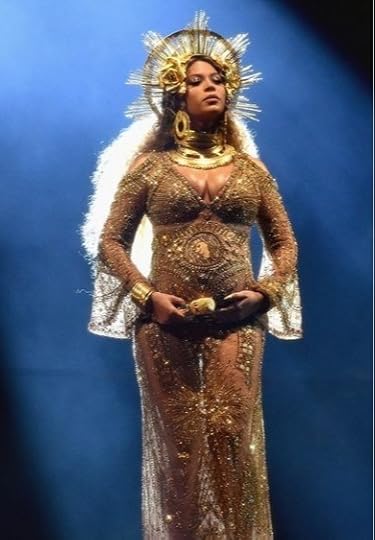
Beyonce at the 2017 Grammys (Getty Images for NARAS)
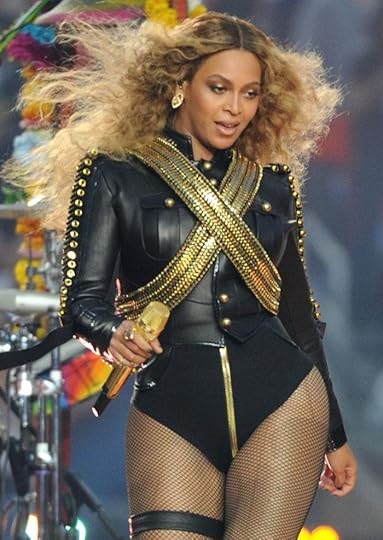
Beyonce at the Super Bowl 2016 (Christopher Polk/Getty Images)
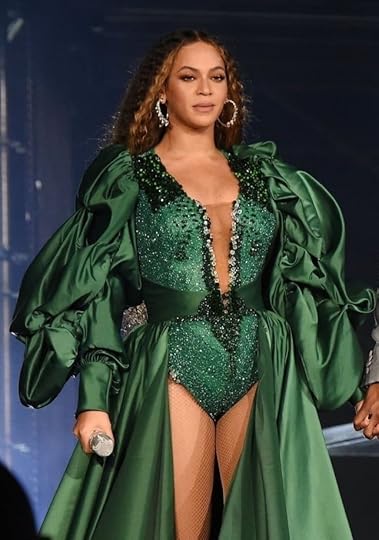
Beyonce in 2018 (Kevin Mazur/Getty Images)
Pop Culture Influences: The character of Catherine is supposed to be inspired by Beyonce, which comes across pretty clearly in her song “No Way.” Stylistically, it fits with Beyonce’s more melodic songs (like “Irreplaceable,” below), and content-wise, the righteous anger throughout reminds me a lot of some of the songs on the brilliant “Lemonade” album (see “Sorry”).
I also think you can see hints of Beyonce in the costume - particularly in the gold “crown” in her hair. The character’s hair (which appears to be a wig, from videos and photos I’ve seen) is very similar to Beyonce’s, albeit shorter (it does appear that the character’s hair started out a lot longer and then was cut down in both volume and length over time). In addition, the overall cut and strong silhouette of the outfit really seems influenced by Beyonce’s style.
I did find a video in which one of the Aragon actresses said she considered Shakira an inspiration for the character as well, but I’m not really finding any Shakira outfits that are similar to this costume at all. I’m guessing that’s really more of a musical inspiration, as there is a definite Latin beat to Aragon’s song, which represents her Spanish heritage.
Accessories Note: Only two queens in the musical have crown-like spikes in their hair, Catherine of Aragon and Anne of Cleves. This may be because their historical counterparts were royal /before/ marrying Henry VIII.
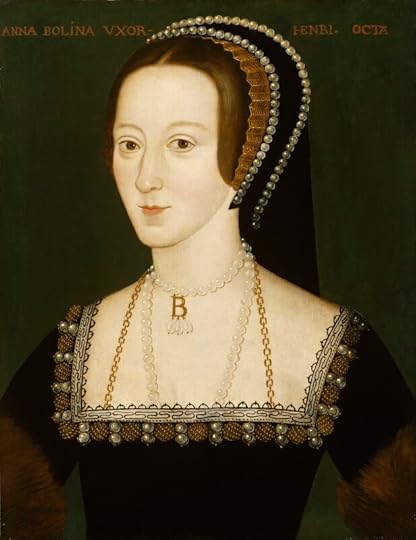
Anne Boleyn, by Unknown English Artist, oil on panel, late 16th century, based on a work of circa 1533-1536
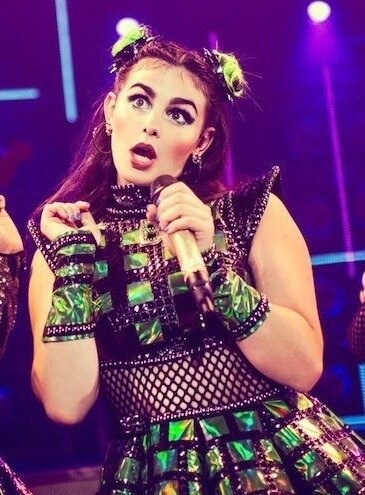
Anne Boleyn, portrayed by Millie O’Connell. (Photographer Unknown)
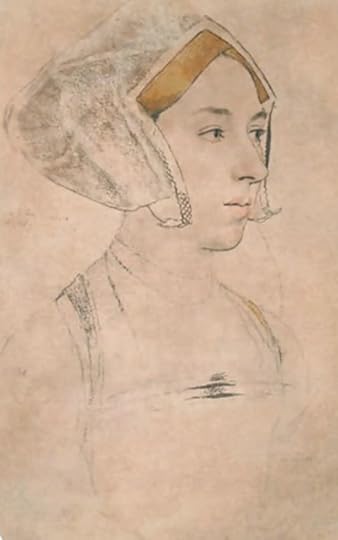
Portrait of a Lady, thought to be Anne Boleyn, by Hans Holbein
I’m that Boleyn girl
And I’m up next, see
I broke England from the Church
Yeah, I’m that sexy
Why did I lose my head?
Well, my sleeves may be green
But my lipstick’s red.
Anne Boleyn - Henry’s second wife (who was queen from May 1533- May 1536) is probably the most well-known and notorious, as she was the victim of a vicious propaganda campaign that has lasted for so long that even well-educated people these days will refer to her as a whore. And honestly, I think you can see a lot of that propaganda even in her song from Six, which characterizes Anne as “just tryin’ to have some fun,” which is in my opinion, tremendously unfair to the brilliant woman she really was. I will write a FULL TED TALK LECTURE worth of opinions for a blog post later, but I should probably give you a brief overview so we can talk about the costumes now, yeah?
Anne Boleyn was Henry’s first English wife, the daughter of a highly respected diplomat and a noble lady from the Howard family (the daughter of the Duke of Norfolk). She was by no means a “commoner,” but she certainly wasn’t a princess like Catherine of Aragon. Anne was considered so precocious and talented that at age 12 (or possibly younger!), she was invited to join the court of Margaret of Austria. In her youth, she also was a maid of honor to Mary Tudor, the new Queen of France, and Queen Claude, the even newer Queen of France (Maids of Honor were young, unmarried noblewomen who attended on women of higher rank). Here, Anne was almost certainly exposed to the ideas of both Renaissance humanism and courtly love (which I’ll explain more in a later post, but didn’t actually involve any physical love), which influenced a lot of her later actions and words.
Anne was recalled to England to marry a cousin to settle a land dispute, but this plan fell through. She went on to the English court to serve Catherine of Aragon and became known as a tremendously charming, intelligent, and quick-witted woman. Henry VIII began pursuing Anne in 1526, but we know from his love letters to her throughout their seven-year courtship that their affair remained unconsummated for a very long time. Both Henry and Anne assumed that his marriage could be annulled fairly easily, as the Pope had granted annulments to several Kings in the past without much fuss. However, Catherine’s connections to the Holy Roman Emperor Charles (her nephew) ensured that this did not happen, and Henry would eventually have to break with the Catholic Church and form the Church of England to get his longed-for annulment. By the that time, most of England and Europe hated Anne and called her a whore. A mob of Londoners actually attacked her during dinner once; she barely got away.
Henry and Anne did eventually get married, after she was already pregnant with the future Princess Elizabeth. By all accounts, she was a doting mother and frequently visited her daughter (and thus, I’m pretty annoyed that Anne’s song in Six literally doesn’t even mention Elizabeth, even though Aragon’s and Seymour’s songs mention their kids). Anne was paranoid for her safety and the safety of her child, and when Henry began pursuing other women at court, she lost her temper at the king publicly several times. Her anger at seeing Henry with Jane Seymour may have led to her final miscarriage.
It’s a bit unclear who actually orchestrated Anne’s downfall - it may have been Henry’s chief minister Thomas Cromwell (although there were numerous sloppy mistakes in the falsified evidence, which seems too careless for Cromwell, IMO). But in the end, Anne would be tried and convicted of high treason due to adultery with five men, including her own brother. All six of the accused were arrested and executed in late April- mid-May 1536. There’s really no evidence supporting any of the charges and historians widely believe that the charges were completely manufactured.
In a final fuck you from the grave though, Anne’s daughter Elizabeth I would ultimately become one of England’s greatest monarchs. She reigned for over 40 years in a golden age of progress and led England to becoming a great world power.
Historical Inspiration: The historical inspiration for this costume is more subtle, but you can still see a few touches. The beading in Anne’s dress is reflected in the silver grommets in the modern costume. The actress also has Anne’s famous dark hair and eyes. Her blush even looks like it might be applied to match Anne’s? And of course, there’s the giant “B” necklace. The green of the costume appears to be tied to the legend that Henry VIII wrote “Greensleeves” about Anne, which is referenced several times in the musical’s soundtrack.
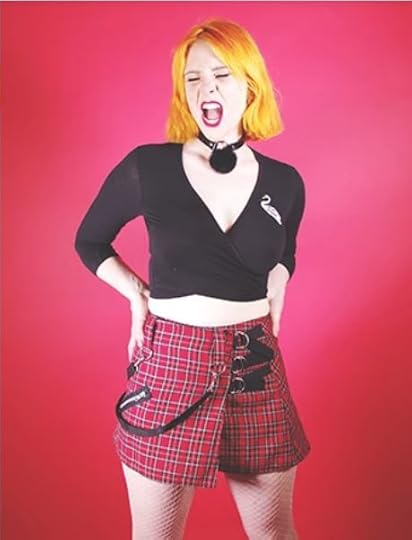
Kate Nash
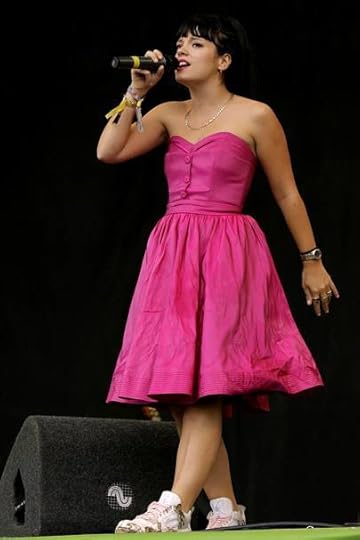
Lily Allen

Avril Lavigne
Pop Culture Inspirations: Anne is supposed to be inspired by Lily Allen, Avril Lavigne, and Kate Nash (per Millie O’Connell, an early originator of the role). The Lily Allen influence is most obvious in Anne’s song “Don’t Lose Ur Head,” which has the same sort of sassy wit and obvious non-posh British accent usually found in Lily Allen’s work. I’m guessing the use of this accent in the song is meant to refer to Anne’s “commoner” status; although she was from a good family, she wasn’t a Spanish princess! (And yes, that could just be the actress’s natural accent, but I’m sure they would have had her sing with a less emphasized accent if they didn’t want it in the story).
The Lily Allen fashion influence seems to come across in the dress silhouette. The punky checks are reminiscent of outfits commonly worn by both Kate Nash and Avril Lavigne (and also can honestly be seen worn by many female artists with a “punk” style, like Gwen Stefani or Pink). The wrist covers are a common punk fashion element as well.
The hair is more confusing though; I couldn’t find any photographs of the stated influences for Anne wearing double buns. However, double buns are pretty popular among young stars that go to Coachella; the real life Anne had a reputation for being very fashionable, so it’s possible this is a reference to that.
Apparently the green hair accessories shown in this photo have been replaced with leather and spikes. Anne’s costume is the only one that exposes the shoulders and a significant amount of arm.
Accessories Note: It appears from photos that the only two queens in the show with choker necklaces/choker style necklines are Anne Boleyn and Katherine Howard, who were both beheaded. They were also cousins and are the only queens to sport their initials on their necklaces.

Kendall Jenner and Chiara Ferragni at Coachella.
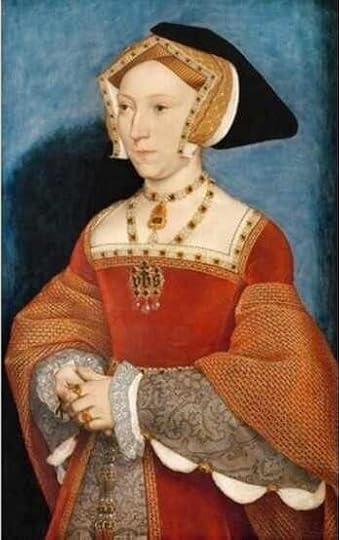
Jane Seymour, Queen of England. Oil on Wood. 1536, by Hans Holbein.
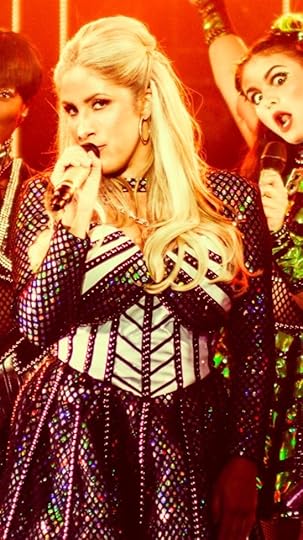
Jane Seymour, portrayed by Natalie Paris. (Photographer Unknown)
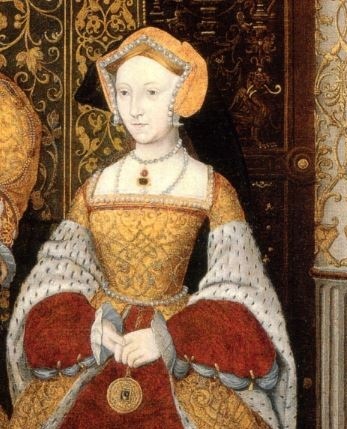
Jane Seymour, from “The Family of Henry VIII” c. 1543-1547. Unknown artist, after Holbein. Hampton Court Palace.
Jane Seymour, the only one he truly loved
(Rude.)
When my son was newly born
I died, but I’m not what I seem?
Or am I?
Stick around and you’ll
Suddenly see more
Jane Seymour was Henry VIII’s third wife and Queen of England from 1536-1537. She was his second English born spouse and the daughter of a courtier who was knighted by Henry VII. She had a much more traditional woman’s education than either Catherine of Aragon or Anne Boleyn and though she could read and write, she was better at household management and needlework. She was from a large family, which may have contributed to Henry’s interest in her, as presumably, she was as fertile as her mother.
Jane was definitely a maid of honor to Catherine of Aragon as of 1532, but may had been serving her for several years before that. She then went on to serve Anne Boleyn. The first reports of Henry courting Jane are from February 1536, about three months before Anne’s execution and indicate that Jane had rejected a gift from Henry. In March, he sent her another gift; she responded by saying that she had “nothing in the world but her honour, which she would not wound for a thousand deaths.” Jane eventually did accept a small portrait of the king, which she wore on a necklace. Henry had given a similar present to Anne during their courtship; it’s reported that Anne snatched the necklace from Jane’s throat when she saw it.
in April 1536, Jane’s brother and sister-in-law moved into Thomas Cromwell’s former chambers in Greenwich, which were connected to Henry’s apartments by a secret passage. Henry visited her there with her family as chaperones. Jane was kept away from court during Anne’s trial, but was betrothed to Henry only a day after Anne was executed. They were married within two weeks.
She had well-publicized sympathies with Catherine of Aragon and Princess Mary and took efforts to reunite Henry with both of his daughters. She was praised by various ambassadors and courtiers as being very gentle, peaceful, and meek (basically the polar opposite of Catherine of Aragon and Anne Boleyn).
Jane Seymour became pregnant in early spring 1537 and gave birth to Prince Edward on October 12. Later that day, she reportedly was sitting up in bed writing letters and received guests on the day of Edward’s Christening. However, she fell ill and passed away on October 24. It’s believed she died of puerperal fever, an infection that can occur after childbirth.
Henry wore black for months after Jane’s death and did not remarry until 1540. Years later, when a family portrait was painted for Henry VIII, the painting included Jane Seymour, her son Edward, and his daughters Mary and Elizabeth. When he died in 1547, he was buried next to Jane’s grave on his request.
Historical Influences: I’m not seeing much of an homage to Seymour’s portrait here, aside from slight similarities in the neckline and necklace line. Jane’s character is depicted with the longest skirt by far, which may be a reference to her meek reputation. She also has the heavy grommets seen in the other costumes, but in silver, rather than in gold. The white in the costume appears to refer to her peace-making efforts. Jane’s dress also has strong armor vibes, although I’m a bit unclear on what that could refer to.
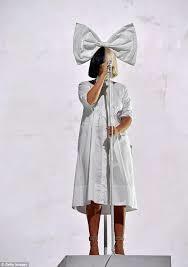
Sia

Adele
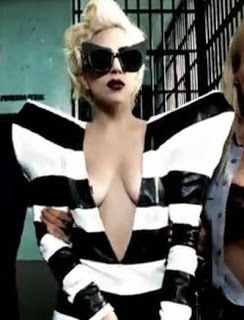
Lady Gaga in her music video for “Telephone”
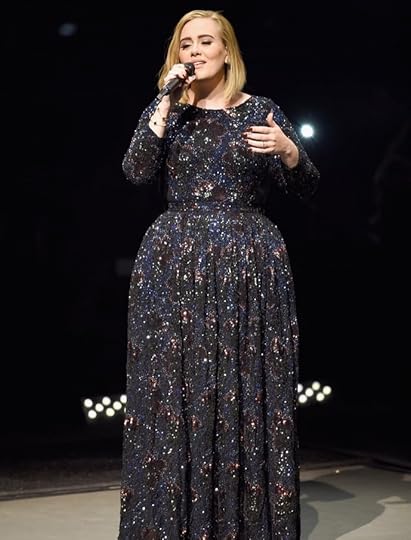
Adele
Pop Culture Influences: Adele, Sia, and Lady Gaga have been listed as inspiration for Jane Seymour in Six. Jane’s power ballad “Heart of Stone” has a definite Adele power ballad feel to it. The piano background is reminiscent of numerous Adele and Lady Gaga songs. The high whistle notes part at the end is a bit more Mariah Carey than any of these singers though, IMO; Gaga and Sia are both known for high /belting/ at the end of songs, but that’s not quite the same.
Adele is known for wearing a LOT of black (in one interview, she said she sometimes goes out wearing color and people don’t recognize her) and she often goes for long sleeves and classic silhouettes that emphasize her hourglass figure, just like Jane’s costume. Sia uses black and white in her wigs and costumes on a pretty regular basis.
I initially thought I’d have trouble finding Lady Gaga inspirations, but the prison dress outfit from the Telephone music video definitely seems similar to Jane’s strong black and white stripes ensemble, plus they both share that trademark light blonde hair. Jane’s pulled back hair with volume seems like a pretty clear Adele reference as well.
Accessories Note: Earlier photos of Jane show that her costume used to incorporate a black leather hair piece with little silver spikes, but that appears to have been removed at this point.



